What Is Thin Content?
Thin content refers to website pages that offer visitors little or no added value.
In other words, they don't answer search intent or help users complete a task.
Thin content pages can have a low word count. But other types of thin content include:
- Thin affiliate pages with little original content, primarily focused on promoting affiliate products without adding substantial value
- Content copied from other sources without permission or attribution, offering no unique insights
- Pages created solely to rank for specific keywords, often leading to similar or duplicate content within the site
- Posts written by guests that lack expertise, originality, or relevance to your site's audience
- Low-quality AI-generated content
Thin content violates Google's spam policies, which can lead to penalties (manual actions). And it can significantly impact your search engine optimization (SEO).
Google's crackdown on thin content began with the 2011 Panda algorithm update. It aimed to lower the rank of sites with poor content quality and improve user experience (UX).
Although the Panda update is over 12 years old, Google still uses its core values as part of its ranking systems today.
For example, you may be familiar with the concept of E-E-A-T.
E-E-A-T stands for Experience, Expertise, Authoritativeness, and Trustworthiness.
Google uses E-E-A-T as part of its search rater guidelines to help raters evaluate whether their search ranking systems provide helpful, relevant information.
That’s why getting rid of thin content is crucial.
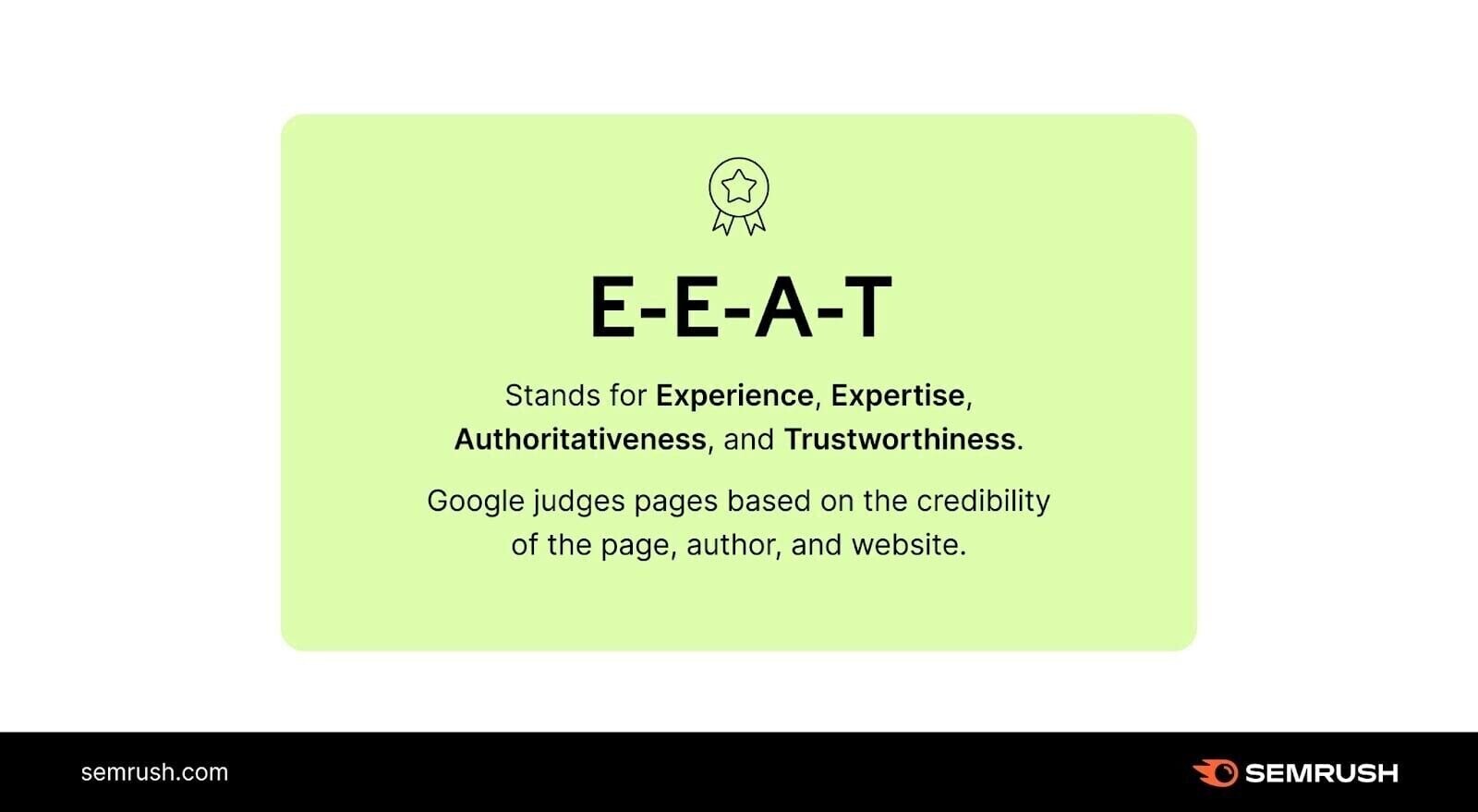
How Thin Content Hurts Your SEO
Beyond violating Google's guidelines, thin content negatively affects your SEO strategy in multiple ways:
- Thin content offers bad user experience. It fails to engage visitors and signals to search engines that your content isn't valuable.
- Thin content is often poorly organized and lacks structure. This makes it hard for users to find the information they need.
- Multiple pages targeting the same keywords can lead to keyword cannibalization. Which can confuse search engines about which page to rank.
Google has two main ways of finding and penalizing thin content:
- Algorithmically, through core updates and ranking systems
- By issuing a manual penalty
Ranking systems now prioritize helpful, reliable, people-first content created to benefit people rather than just gain SEO rankings.
The Google algorithm is constantly moving around search results. But the algorithm isn’t perfect.
That is why sometimes it will issue a manual penalty.
Typical characteristics of "SEO content" that Google aims to devalue include:
- Primarily created to manipulate search rankings rather than help users
- Lacking original information or insights
- Copied or rewritten from other sources without adding value
- Not demonstrating expertise in the topic
Further reading: Quality Content: What It Is + 10 Actionable Tips for Success
Types of Thin Content
There are many different types of thin content. Here are a few of the most common:
1. Content That Isn’t Helpful
Google's ranking systems prioritize content that is informative, trustworthy, and genuinely helpful to users. Thin content doesn't meet these criteria and is often seen as lacking E-E-A-T.
It might also lack depth or usefulness and fail to delve deep enough into the topic.
For example, a travel guide for a city that only lists a few popular landmarks without providing details on transportation, local customs, or hidden gems would fall short.
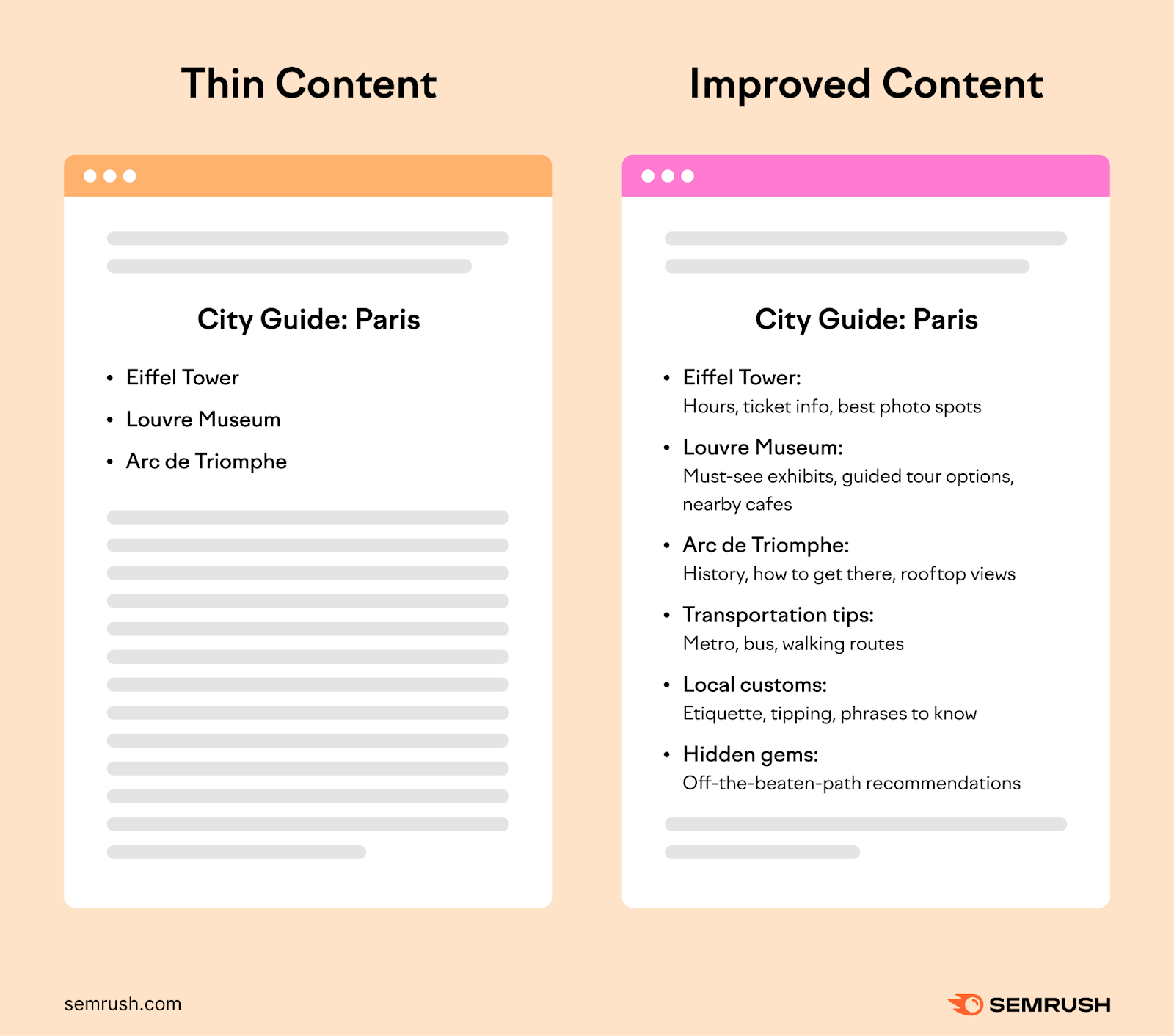
This content may be too short, lack original insights, or simply rehash information readily available elsewhere.
To ensure your content is truly helpful, consider these questions:
- Does the content provide original information, research, or analysis?
- Is the author or creator clearly identified?
- Does the content come from a reputable source?
- Is the content well-written and free of errors?
- Does the content provide value compared to other content on the same topic?
Further reading: Check out Google’s guidelines on creating helpful content for a full list of self-evaluating questions.
2. Poorly Written Content
If your blog articles or webpages contain grammatical errors, typos, or awkward phrasing, Google might perceive them as low-quality or thin content.
Think of it like this:
Would you trust a restaurant with a menu full of spelling mistakes and food descriptions that don't make sense?
Probably not.
The same principle applies to your website.
Even if you have valuable information to share, poor writing can make it difficult for readers to engage with your content, leading them to seek more polished alternatives.
Let’s say you write an article because you want to rank for a specific search query.
You don’t think about teaching the audience anything. And instead of creating a helpful guide, you force in the keywords repeatedly.
You’d end up with a piece of content like this:

This example is older since most bloggers no longer write like this.
This content is thin because it lacks a real strategy or flow and is laden with grammatical errors.
However, important pages for ecommerce businesses can also be deemed “thin” for the same reasons.
For example, shopping carts and category pages. These may not appear to Google to be valuable for the same reasons.
In those cases, you can use the “noindex” directive to tell Google not to rank them.
3. Low-Quality Affiliate Content
Affiliate marketing is a performance-based advertising method. Businesses pay people or other companies a commission on conversions they acquire.
In other words, you can earn money by promoting other people’s products without holding any stock.
Affiliate marketing is a legitimate arrangement. Done right, you can use it to make passive income or acquire targeted traffic of your own.
Here’s a good example of how home barista site Homegrounds includes affiliate links in its handy guides:

This is the URL to Atlas Coffee Club that pops up when you click the title:
https://atlascoffeeclub.com/?ref_coupon=HOMEGROUNDS&utm_source=pepperjam&utm_medium=affiliate&utm_campaign=164971&utm_content=3-211372&clickId=4428030818The URL is so long because it’s tracking where visitors to Atlas came from. This one shows it’s an affiliate link from Homegrounds.
Whenever a visitor comes from the Homegrounds site and makes a purchase on Atlas, Homegrounds will get a commission.
If Homegrounds used thin affiliate content, they would simply copy the wording on Atlas Coffee Club’s homepage:
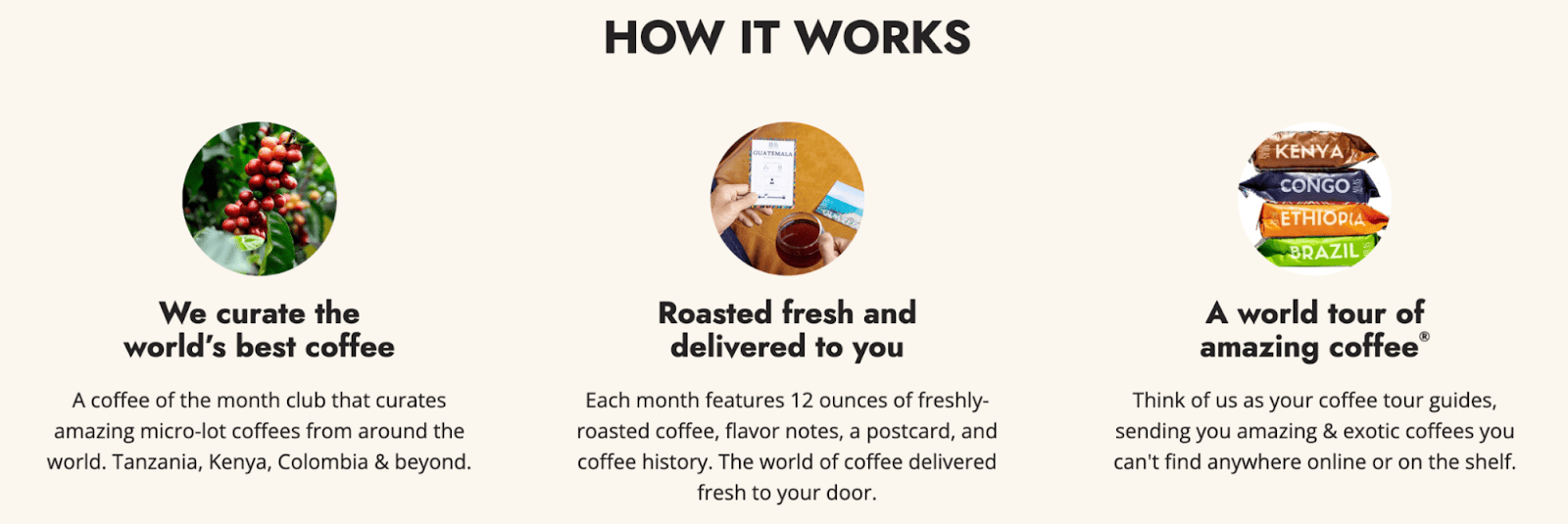
Instead, they explain in their own words why they think Atlas Coffee Club is so great.

To avoid Google labeling your affiliate pages as “thin,” you need to create a clear connection between both sites.
Plus, you need to add value with original content.
Otherwise, what new information is your affiliate site offering that the original isn’t?
If you're unsure whether your affiliate content is hitting the mark, check out Google's guidelines on creating high-quality reviews.
They offer some handy tips, like evaluating your content from a user's perspective, demonstrating your expertise, and providing evidence to support your claims.
4. Scraped Content
Scraped content is simply content copied from other sources without permission or attribution.
This can range from outright copying and pasting to slightly modifying the original text using synonyms or automated techniques.
It's like taking someone else's recipe and passing it off as your own—it is a form of plagiarism and offers no unique value to readers.
Think of it this way:
Imagine finding two websites with the exact same information. Which one would you trust more?
It's probably the one who wrote it first. That's because the original creator spent time and effort sharing their knowledge.
Search engines like Google are smart enough to spot scraped content and can punish websites that use it by making them harder to find in search results.
If you're worried someone is stealing your content, you can use a tool like Copyscape to find copies online.
For example, we found a website copying from our Semrush homepage:
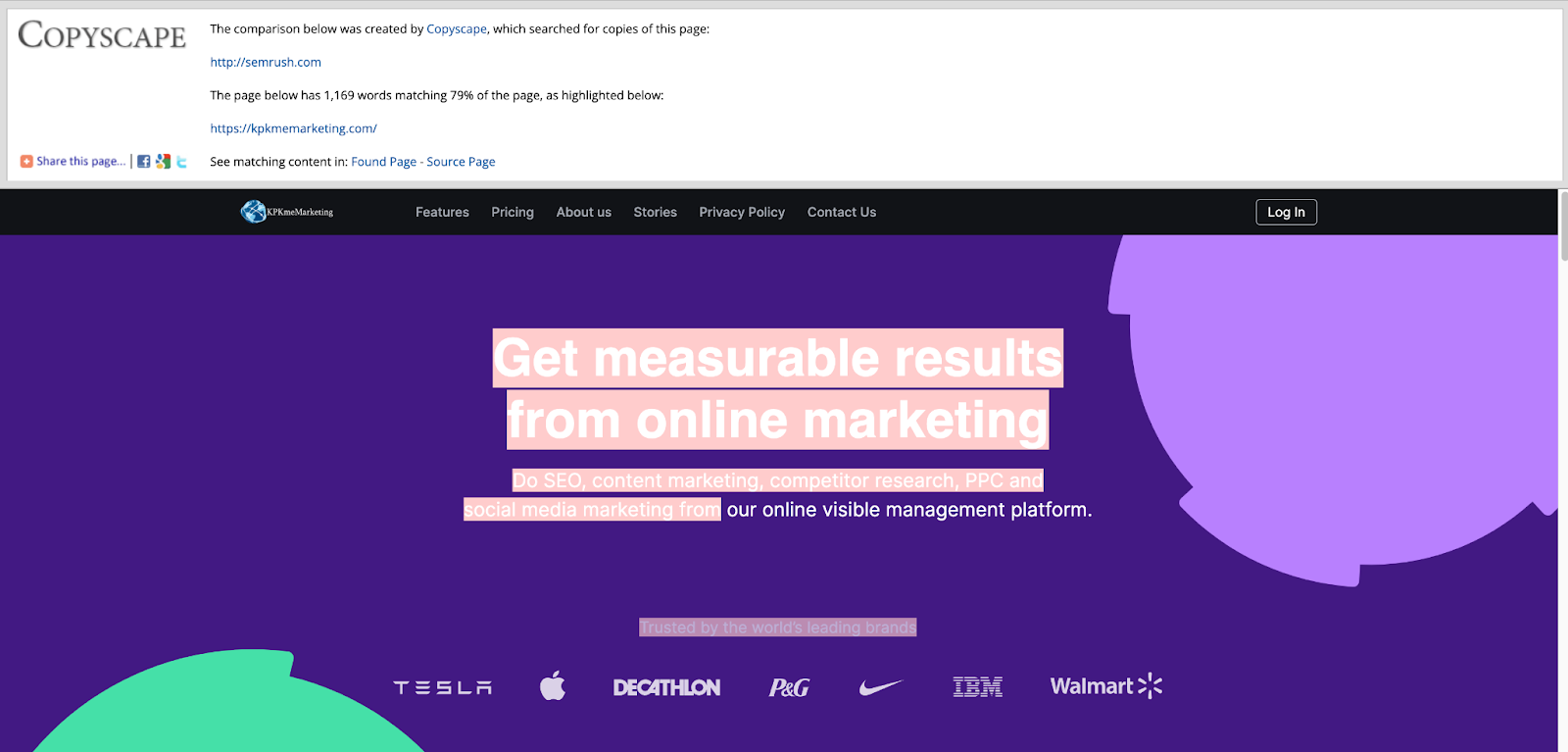
And if we check this website in Semrush’s Organic Research tool, we can see the website has zero visibility in search engines.
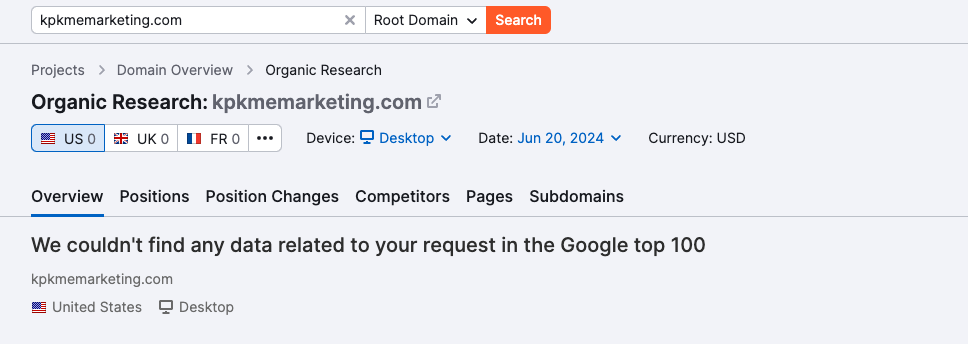
5. Pages With Too Many Ads
While ads are common for websites to generate revenue, too many can create a poor user experience.
Think of it like a billboard-filled highway: Too much visual noise can be overwhelming and detract from the journey itself.

This popular Reddit thread clearly shows that many users find excessive ads frustrating and disruptive to their browsing experience.
When ads dominate a webpage, they can distract from the main content, slow down loading times, and even make it difficult to navigate the site.
Google recognizes the importance of a positive user experience and may penalize websites that overload their pages with excessive advertising.
This aligns with Lily Ray's observation in her tweet that many websites experiencing ranking drops after the March 2024 core update (which apparently targeted spammy, low-quality content) are publisher sites relying heavily on ad revenue.

Striking a balance between monetization and user experience is crucial.
Ads should complement your content—not overshadow it.
6. Duplicate Content
Google may view duplicate content (with the same titles, page content, and meta descriptions) as another type of thin page.
This can apply to content copied from other sites, as well as content that’s the same across your own site.
And swapping a few words alone won’t distinguish the pages as separate content.
For example, sticking to the same sentence format but using synonyms:
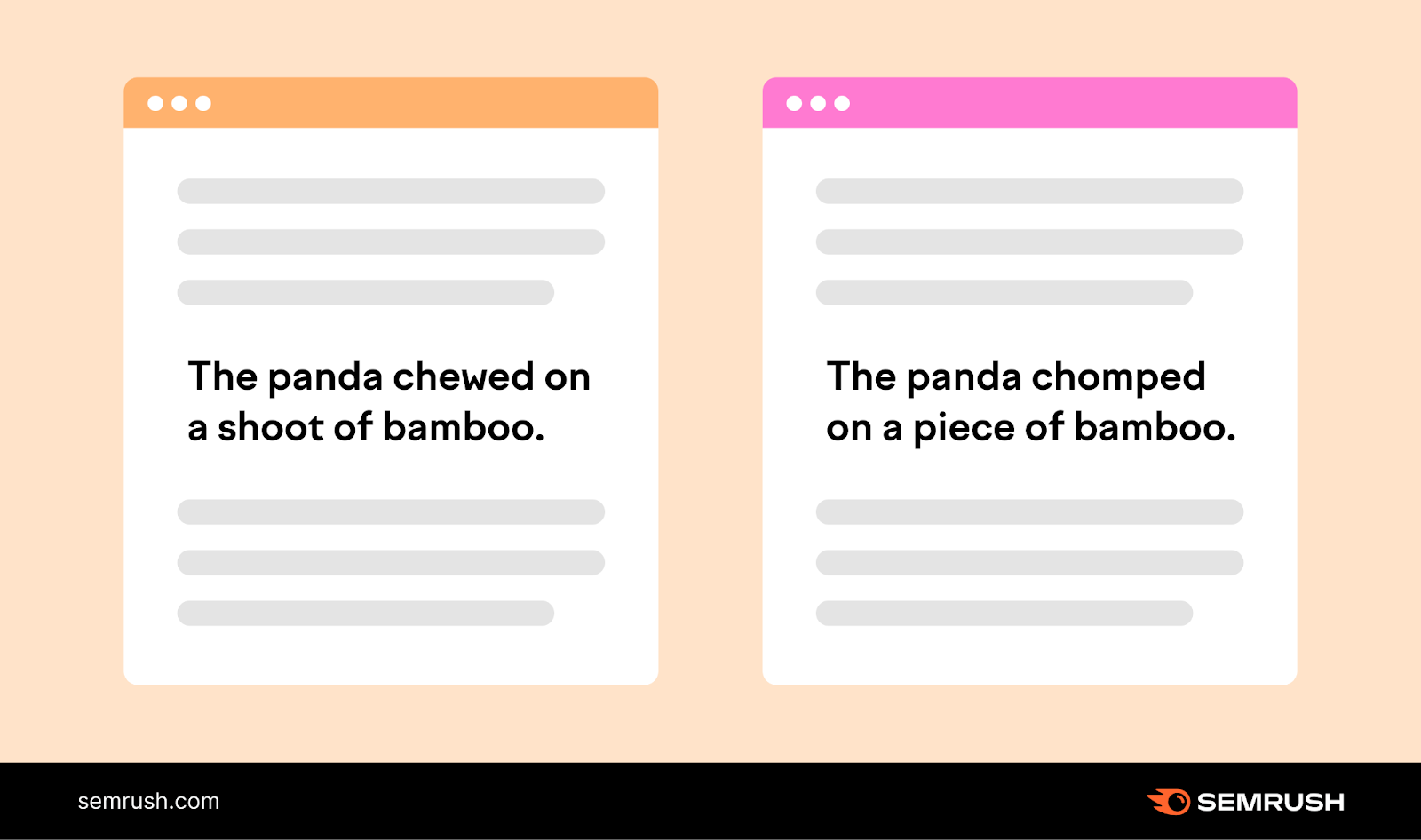
Google dislikes multiple versions of the same content.
Why?
Because it doesn’t want to show users the same results and waste crawling resources. The search engine is all about answering users’ questions as quickly as possible.
But what about those times you’re duplicating on purpose?
For example, you need to show the same content on your category and product pages.
In these cases, you can “tell” Google it's intentional with a snippet of code. Canonical tags point from the alternate page (the duplicate) to the preferred page.
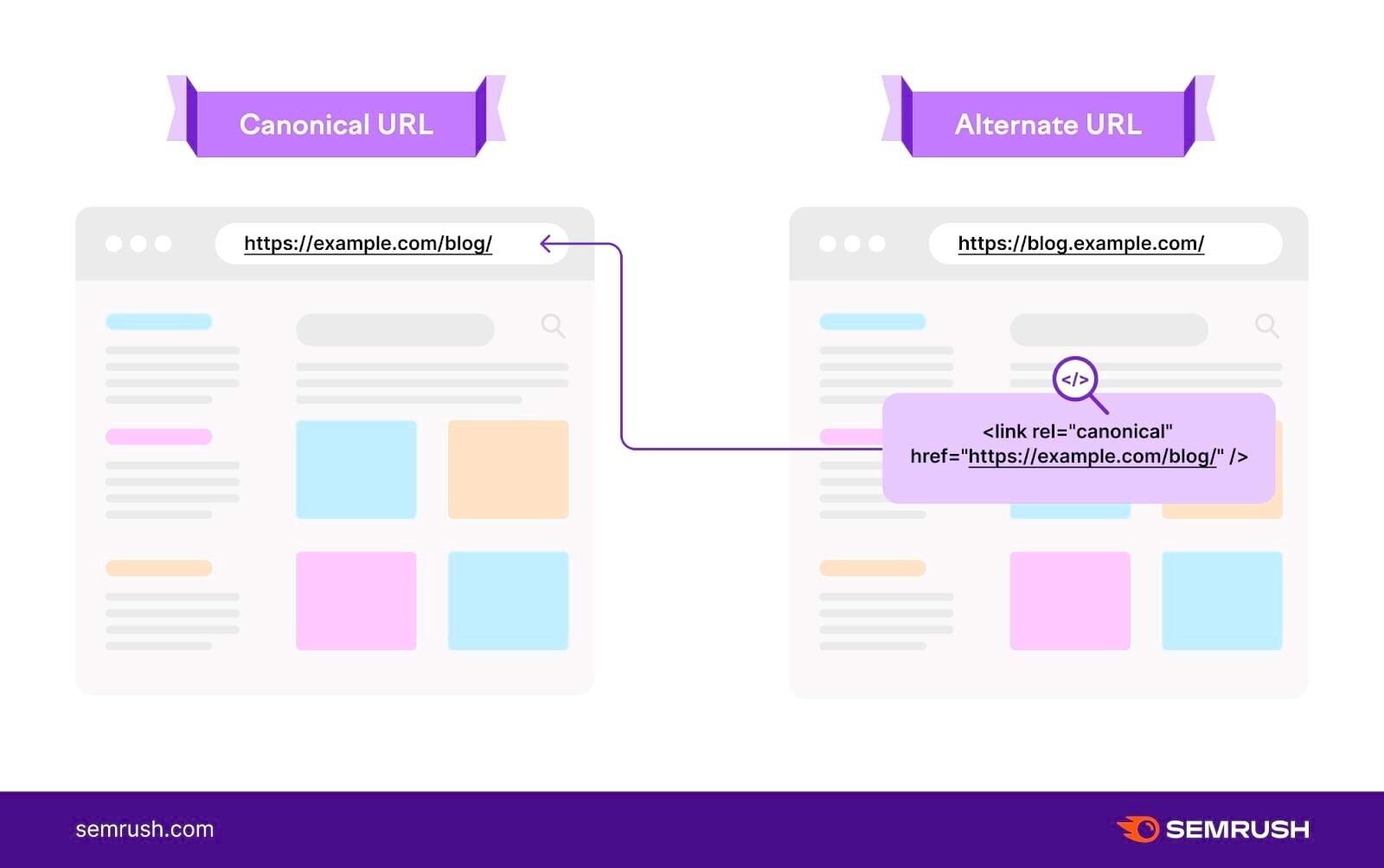
These tags prevent Google from penalizing intentional pages.
7. Doorway Pages
Doorway pages are pages of low-quality content that try to rank by stuffing in keywords or links to low-value sites. People usually create them to increase their site’s footprint in the SERPs with less effort.
These exist to funnel visitors to other pages. And doorway pages are usually full of keyword variations, links, or ads.
Here’s an example:
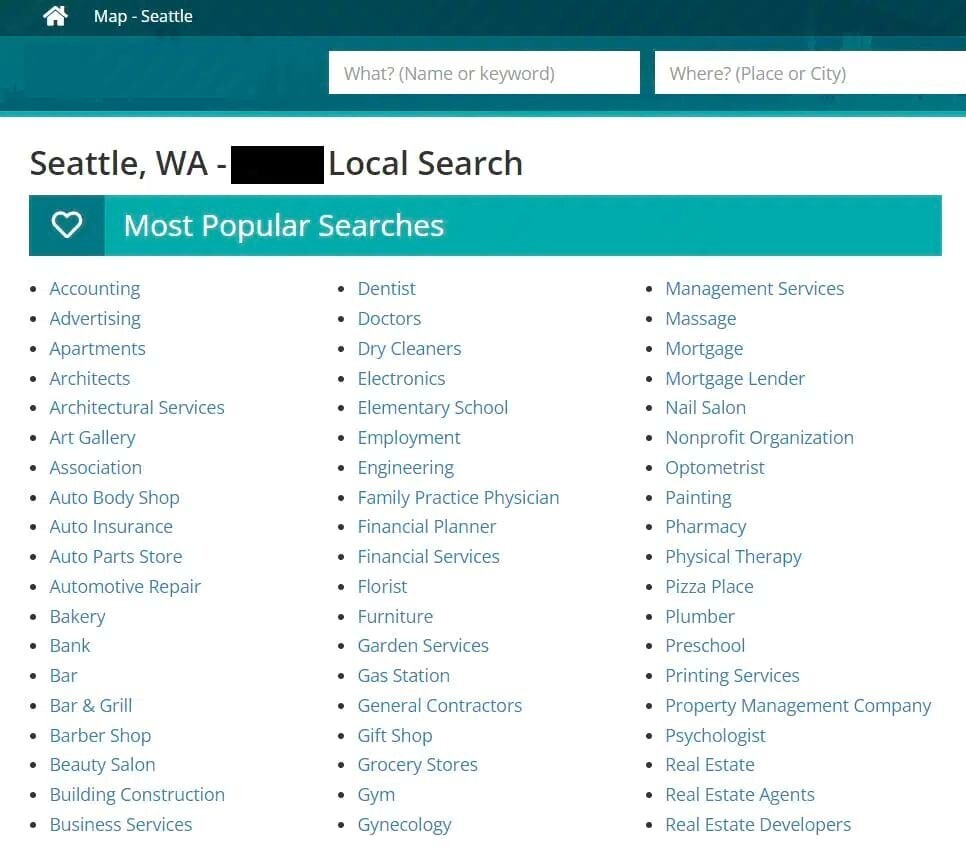
Image Source: Search Engine Land
There’s no unique value here. This page’s sole purpose is to direct users to these linked pages.
People can create doorway pages to manipulate search engines deliberately. Or by accident because they don’t realize the content is thin.
Google can also mislabel legitimate pages as doorways.
For example, these variations on the Hertz van hire landing page might look suspicious at first glance:
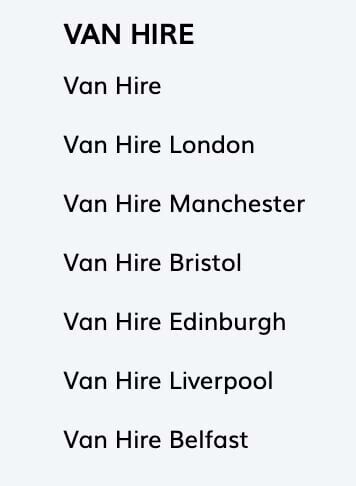
But in this case, each landing page creates clarity for users.
The service may be the same. But people looking for van hire in London will need different information from those in Belfast.
8. Pages With Spammy or Irrelevant Links
People use spammy links to manipulate search engines and gain traction in the SERPs. For instance, buying links on other sites or selling your own.
Here’s an example from Google’s Spam Policies of what that looks like:

These links to commercial pages are “thin” because the writer doesn’t use them meaningfully or teach anything useful.
Links help Google determine how relevant a webpage is to a search query.
They’re also how search engine crawlers move around your site and understand the hierarchy:
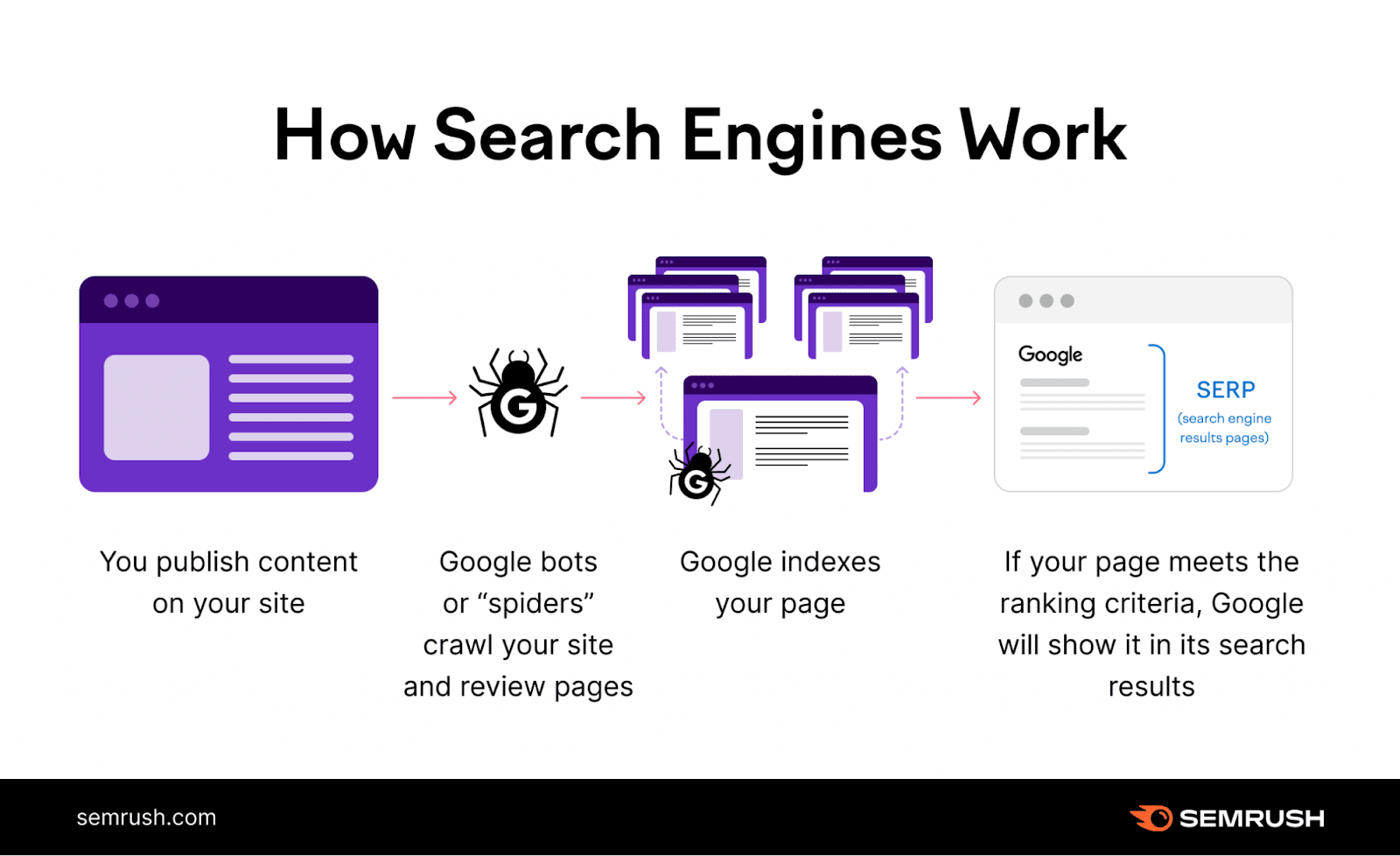
Using them deceptively or incorrectly is a fast way to drop down the SERPs.
How to Identify Thin Content
There are three main ways to check if your site content is thin:
1. Check Google Search Console and Analytics
Check to see if Google has hit you with any manual action penalties by logging into Google Search Console.
Head to the “Security & Manual Actions” tab in the sidebar.
Then click “Manual actions” to reveal any penalties:

You’ll see a list of issues you need to fix or a message that says “No issues detected.”
Once you update your thin content, you can request a review in Search Console. The webspam team will check your changes and (if sufficient) may remove your penalty.
Once your manual actions are clear, head to Google Analytics to check for additional thin content.
Here, you want to study your organic traffic and look out for any drops.
These dips could be due to:
- Previous manual actions
- Algorithm changes
- Seasonality
- Reporting glitches
You’re looking for patterns like those on the left where a drop in traffic doesn’t bounce back:

Both of these reasons for a drop in traffic may result from thin content.
Assess both types of “technical issue” drops and note which pages aren’t getting any visitors.
They could be the cause.
If traffic is consistently low for these pages, note them in your spreadsheet and include them in your read-through.
2. Run a Site Audit and Fix Technical Issues
Perform a full site audit with a tool like Semrush’s Site Audit to highlight technical issues causing thin or low-quality pages, specifically those caused by duplicate content.
To set up an audit, you first need to create a project.
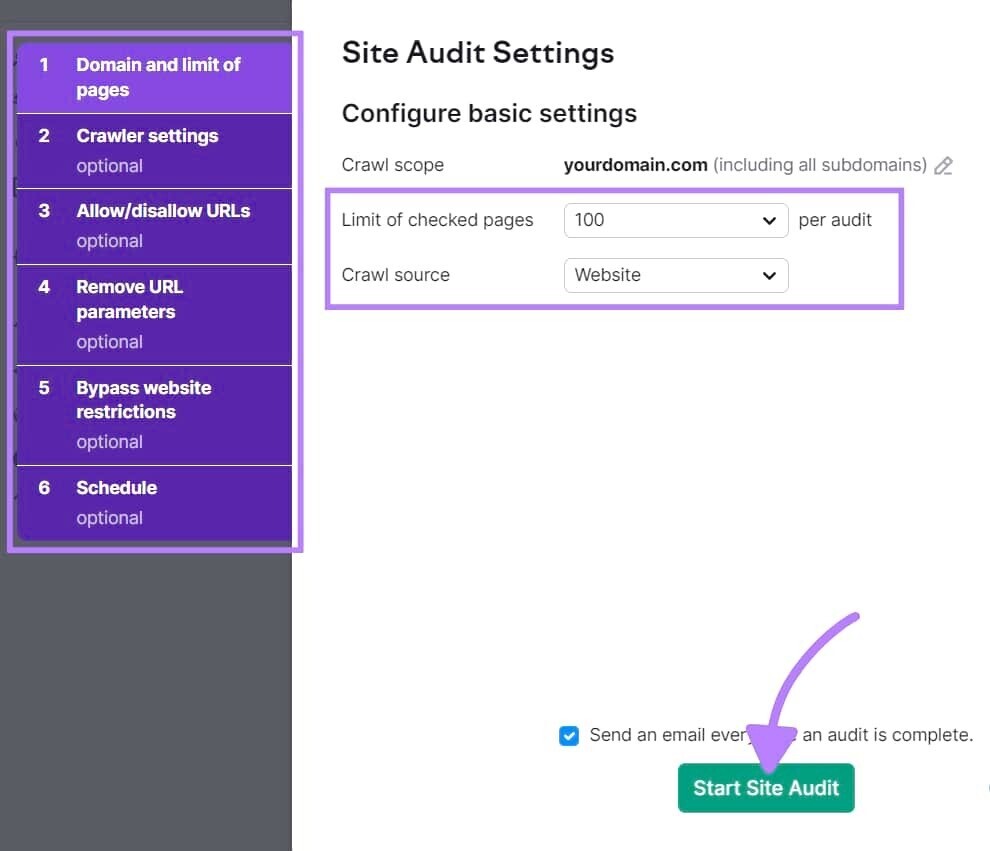
Next, you’ll need to set up your audit. There are quite a few steps to that. So, check out our guide for a more detailed walkthrough.
Once you’ve created your project and configured your audit, click “Start Site Audit.”
The tool then crawls your pages.
And the Site Audit dashboard will look like this:
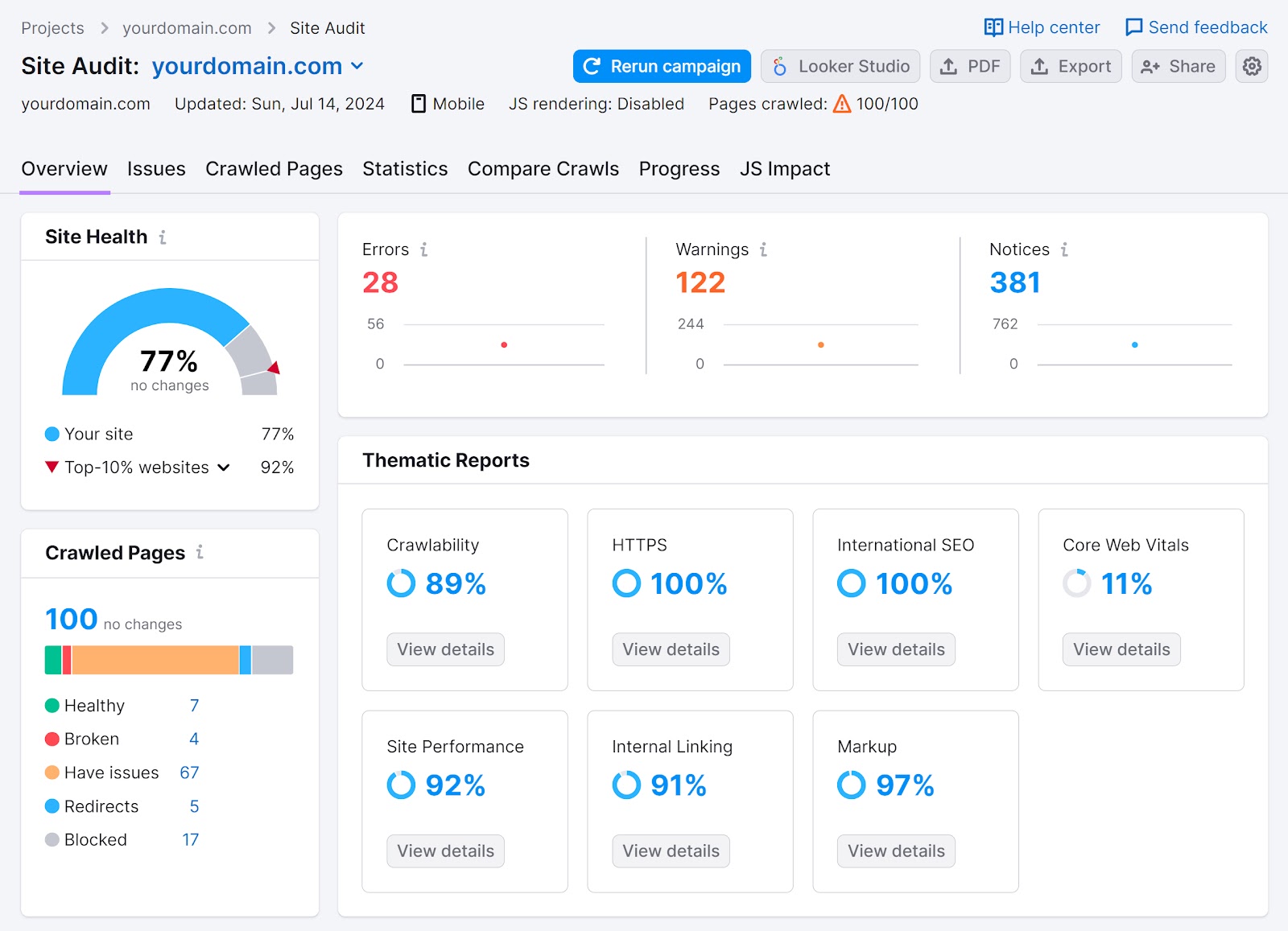
The SiteHealth score will indicate the overall technical health of your website.
We base this metric on the number of issues found and their seriousness.
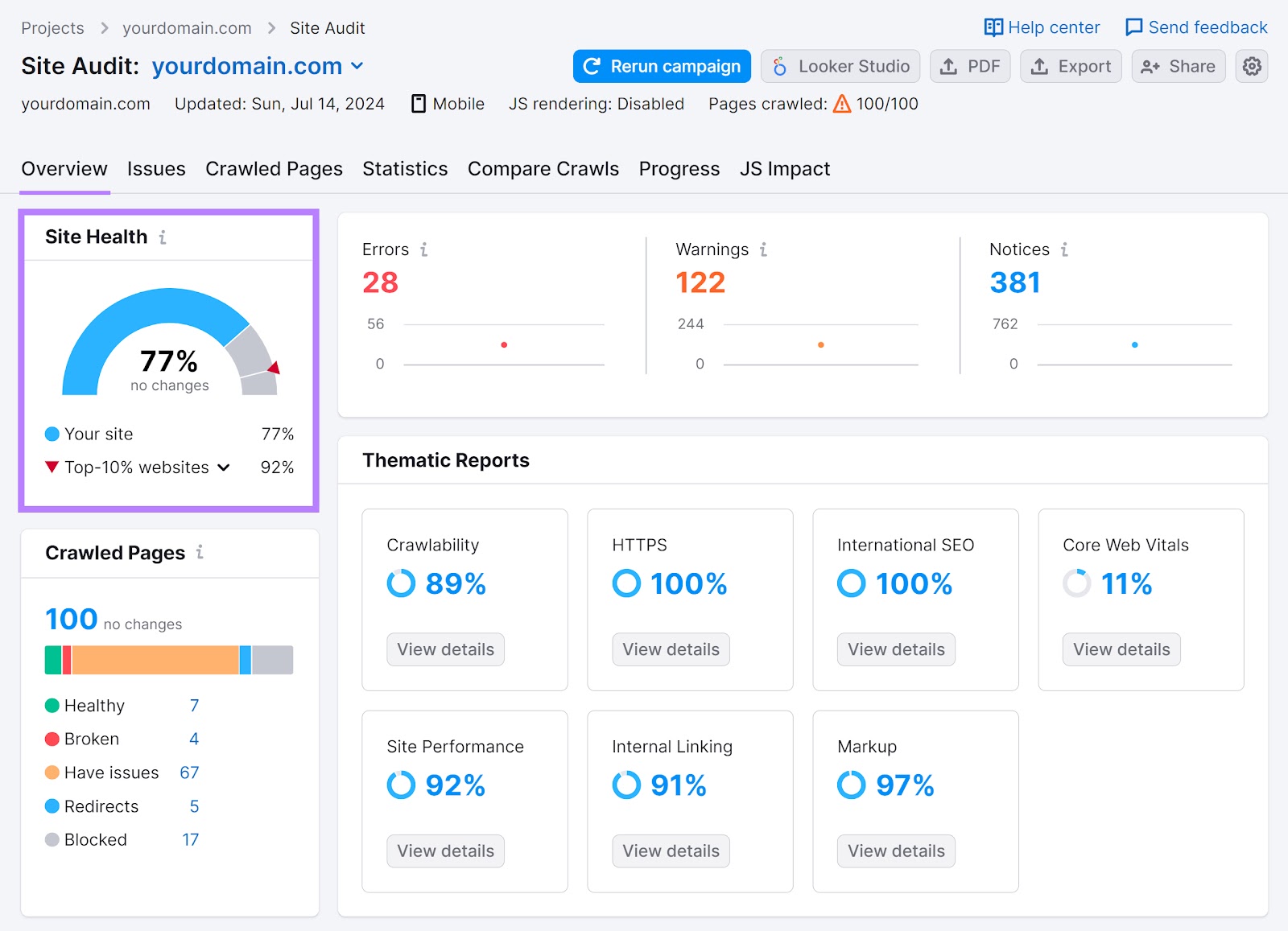
Site Audit divides issues into three categories:
- Errors (most severe)
- Warnings (medium severity)
- Notices (least severe)
Use these distinctions to prioritize your fixes.

You’ll also find a “Thematic Reports” section that allows you to examine various aspects of your technical SEO.
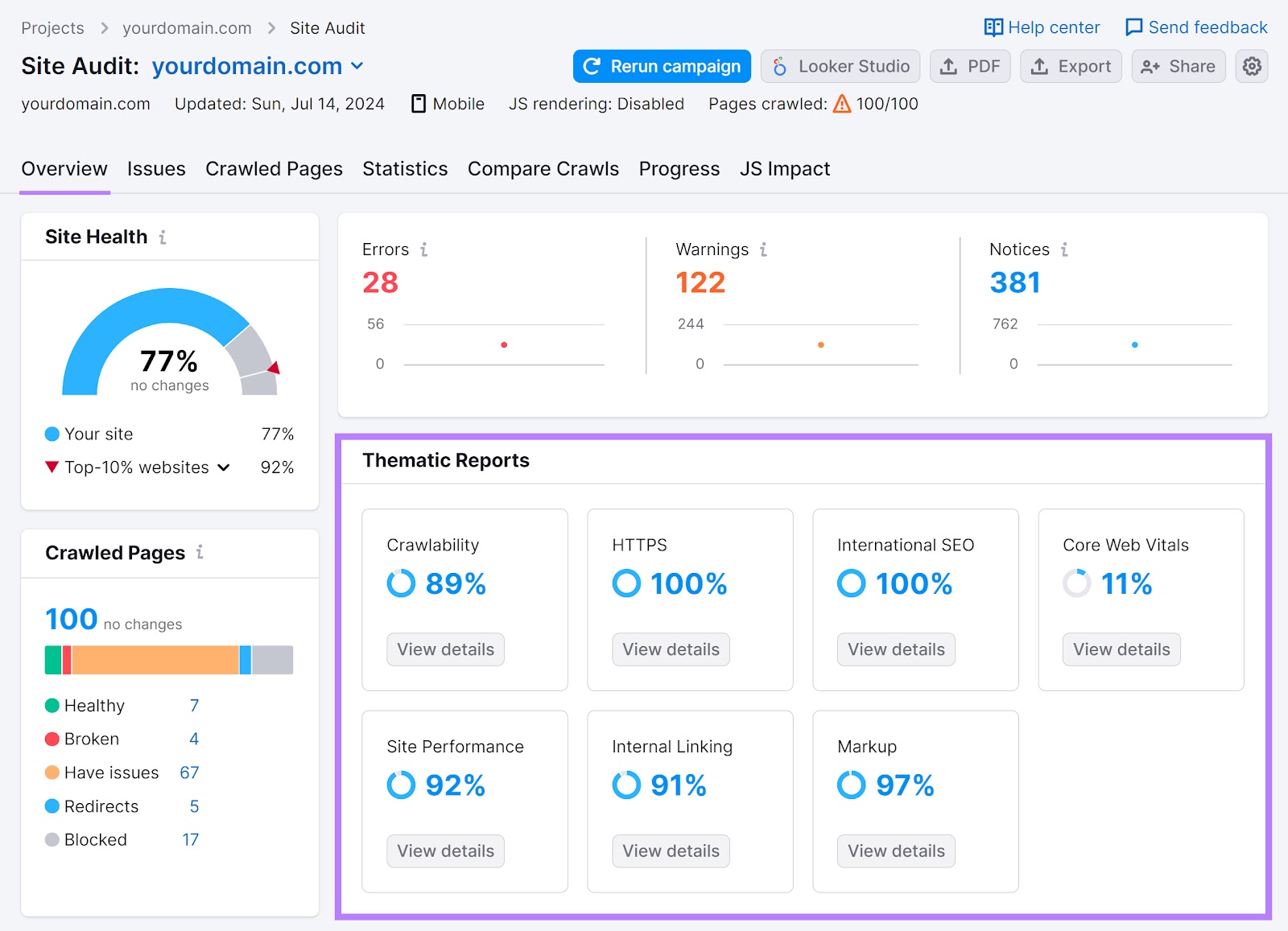
To see all your site’s problems in one place, click on the “Issues” tab at the top of your site audit dashboard.
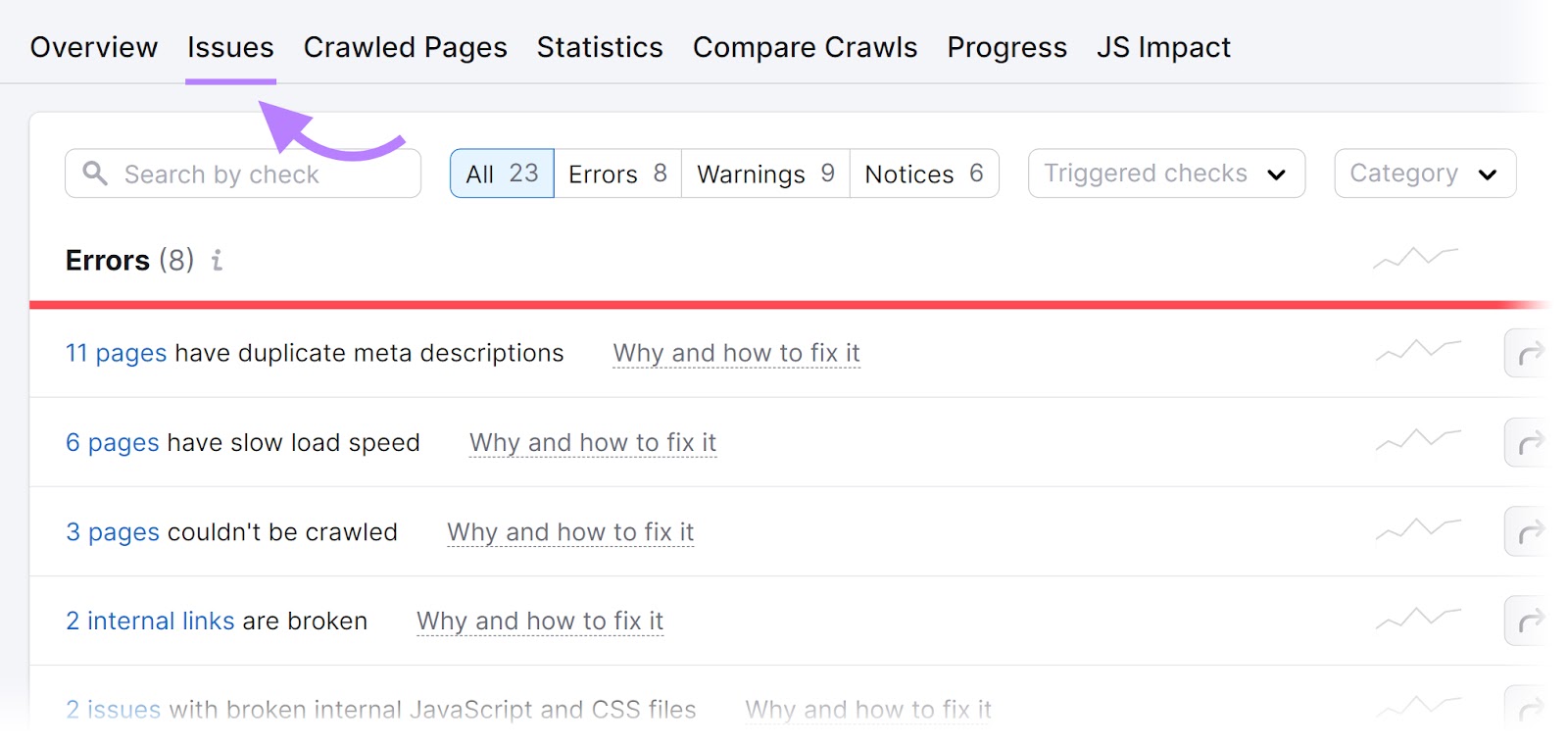
Then, review the issues and start fixing them.
Clicking on each will show you all the audited URLs the issue affects.

You may encounter:
- Duplicate content issues
- Internal linking issues
- Redirect issues
- Title tag issues
- Performance issues
If unsure where to start, click the “Why and how to fix it” link next to an issue.
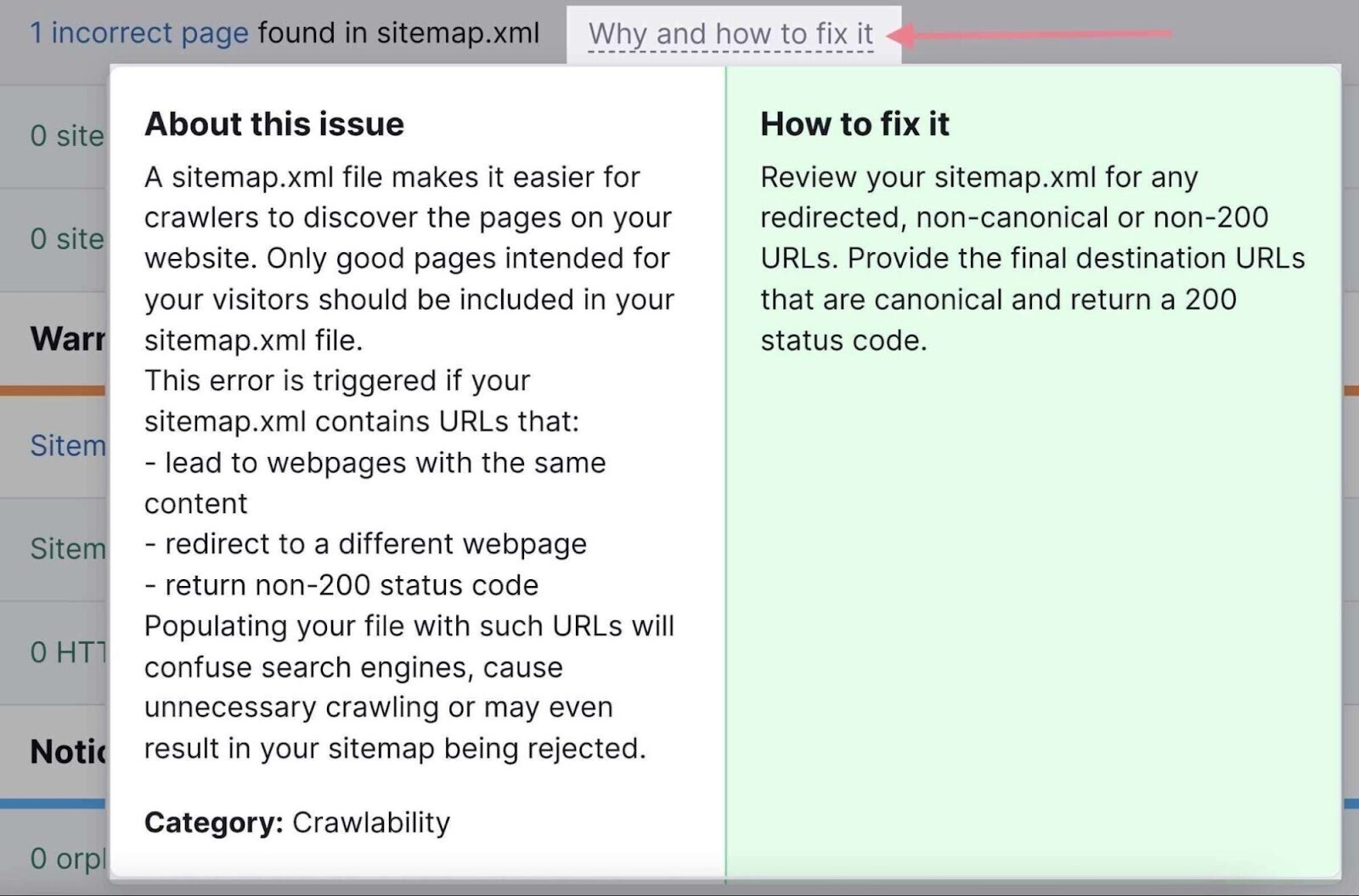
You’ll get an explanation and a short how-to guide for each optimization.
Once you’ve fixed everything, you’ll know technical issues aren’t responsible for any thin content issues.
3. Read Through Your Webpages
Read through the content on your site like a new reader.
High-quality content should teach readers something. They should understand:
- What you're explaining
- Why it relates to the topic
- How to do it
If your page doesn’t answer their questions, it’s likely thin content.
Identifying thin content through reading is a slow, manual process. But it’s necessary.
Create a spreadsheet to keep your content audit organized:
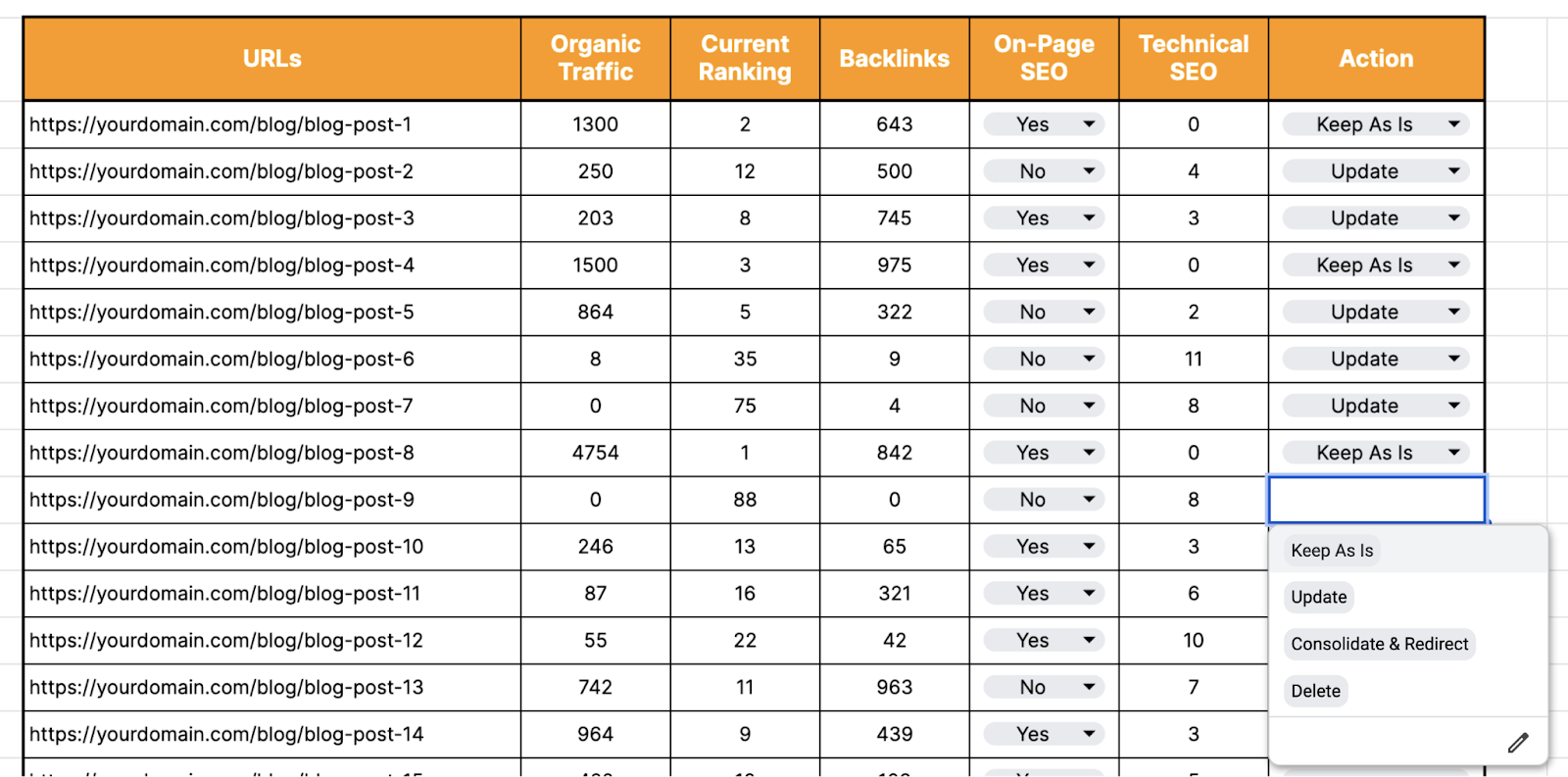
Check off the pieces of content you’ve read. And note the ones you’ll need to update. That way, you can stay on track.
How to Fix Thin Content
Add Value to It
The most direct way to fix thin content is to enrich it with valuable information. This can involve:
- Expanding on the topic: Dive deeper into the subject matter, providing more details, examples, data, or expert opinions. Aim for a comprehensive word count that covers the topic without adding unnecessary fluff.
- Answering user intent: Consider your target audience's questions and address them directly in your content. Ensure your content aligns with the search intent behind their search queries.
- Updating outdated information: If your content is old, run a content audit to identify outdated pieces. Then, refresh them with your industry's latest data, trends, or developments.
- Incorporating visuals: Break up large blocks of text with relevant images, infographics, or videos to enhance readability and provide additional information.
Further reading: Check out our guide on creating quality content for specific examples.
Redirect It
What do you do if you find unhelpful, irrelevant pages with no traffic? Redirect them to other pages or delete them.
A 301 redirect is an HTTP status code indicating a permanently moved webpage.
It sends users and search engines from the old page to the new one.
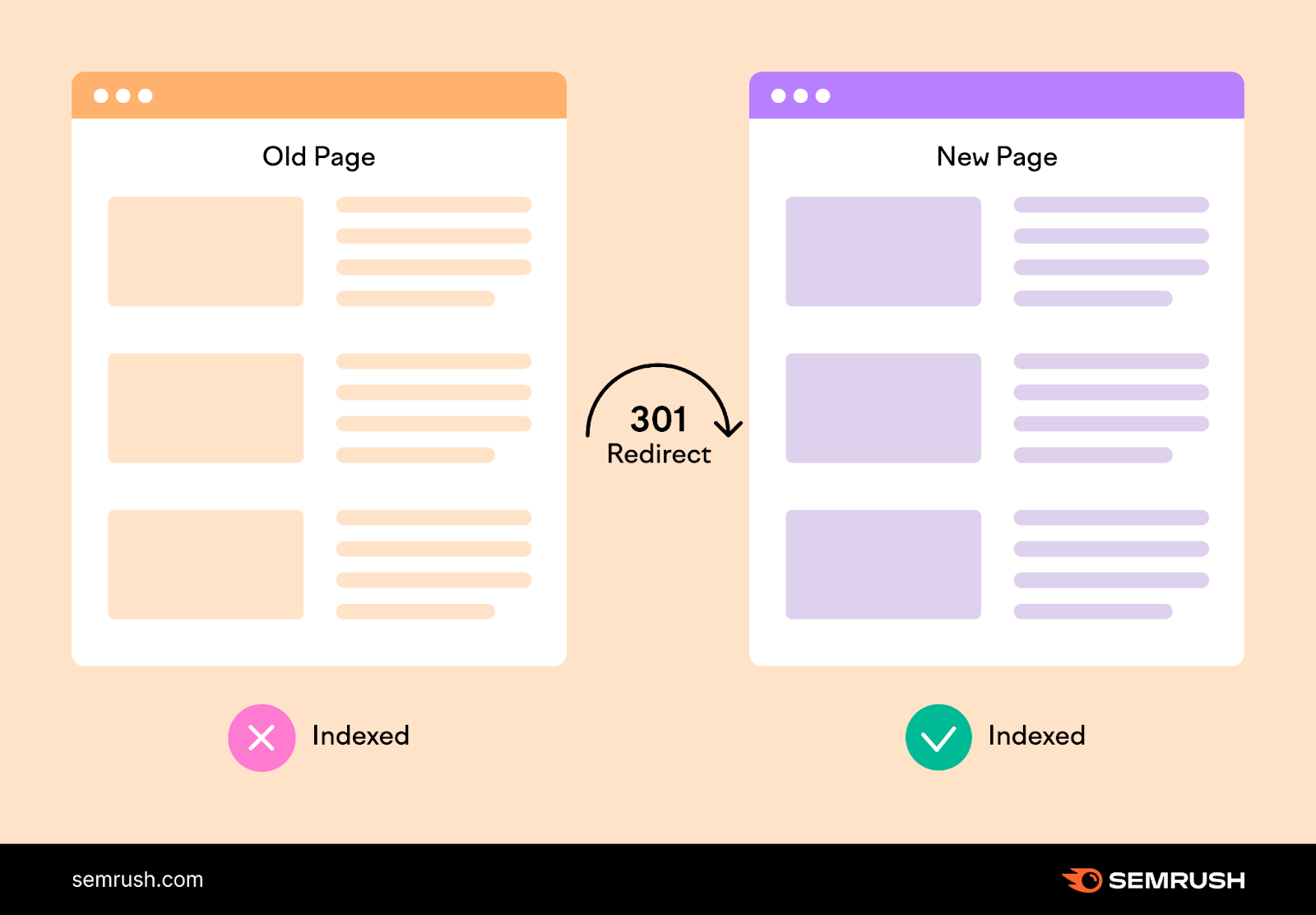
If the older page has backlinks, redirecting it passes on some of the value you’ve gained there instead of losing it.
So, how do you implement a 301 redirect?
If you have a WordPress site, you can use the redirect manager in a plugin like Yoast SEO Premium.

Or if you have a Shopify store, head to the “Navigation” tab in the drop-down menu.
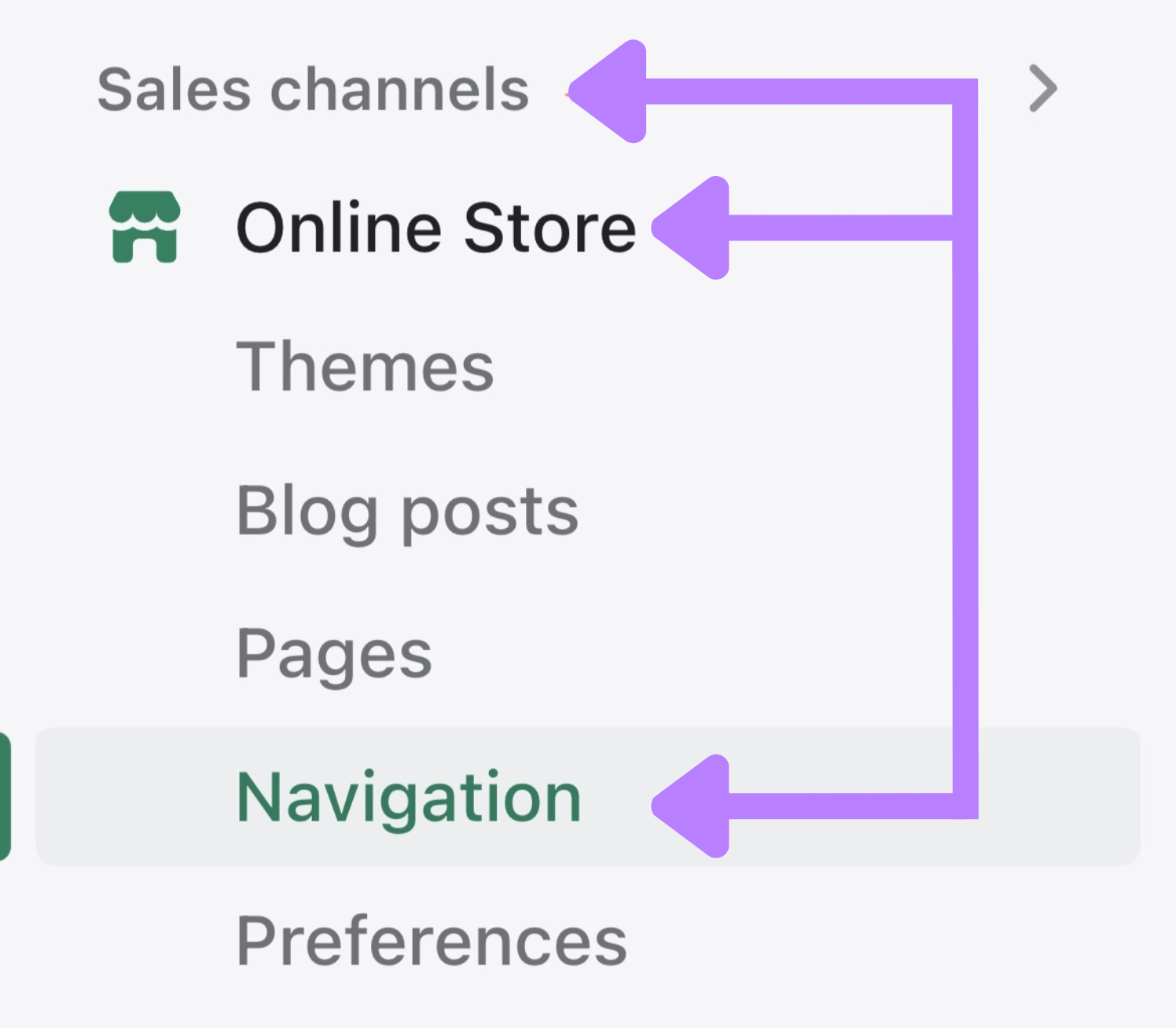
Follow our 301 redirect guide for a walkthrough of both and more options.
If you choose to delete content with a 404 code instead, users will see a page like this:
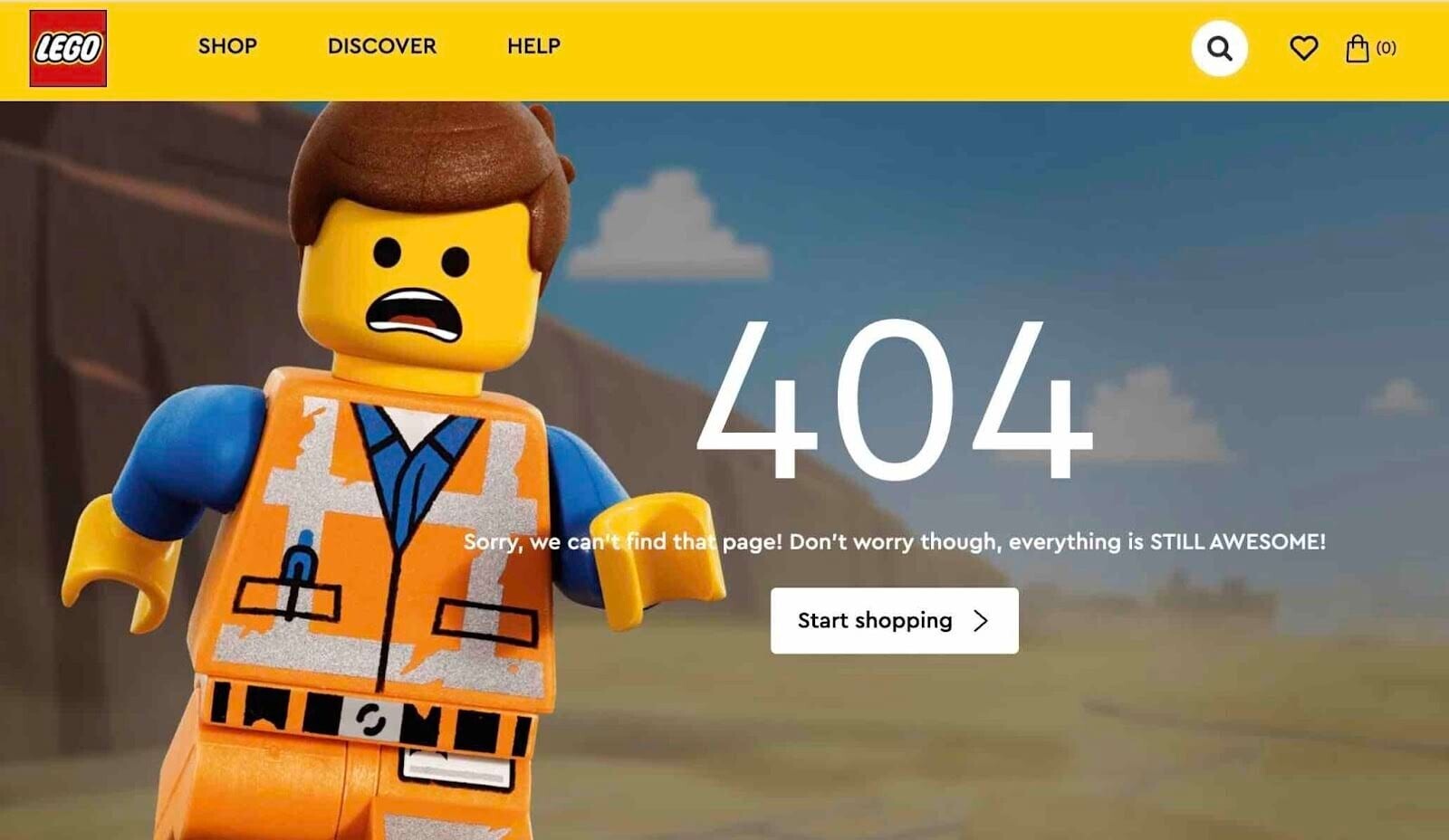
While a 404 code lets search engines know to disregard the page, it’s not great for UX.
That’s why it’s often preferable to redirect if you can.
Combine It With Other Content
If you have multiple pieces of thin content on similar topics, consider merging them into a comprehensive resource.
Let’s say you have a short article called “Can dogs eat apples?” And another called “Can dogs eat bananas?”
You could combine the two into an ultimate guide called “Can dogs eat fruit?” Then, cover all the types of safe fruit to feed dogs.
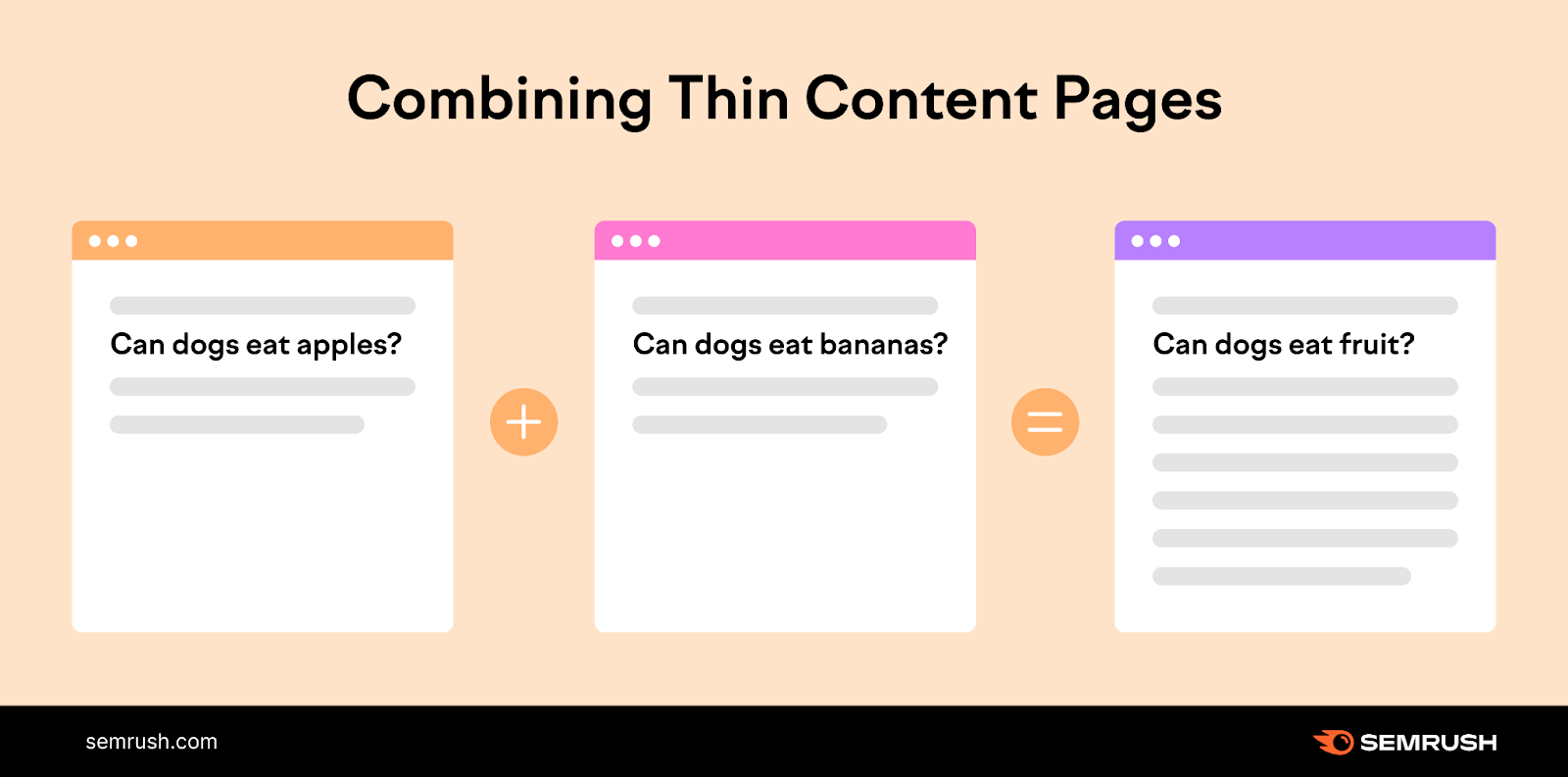
This improves user experience and increases your SEO visibility for that page by targeting a wider range of relevant keywords related to the topic.
Refocus it
Implementing a keyword research strategy can help refocus thin content.
That’s because it increases the likelihood of answering user intent and teaching the reader something (the opposite of thin content).
Semrush’s Keyword Magic Tool can make this process a breeze.
Before you start, figure out your thin content’s central message. If it doesn’t have one, choose the closest related topic.
You’ll use this term as your seed term in the tool.
Let’s say it’s “dogfood.” Start by entering it into the search bar.
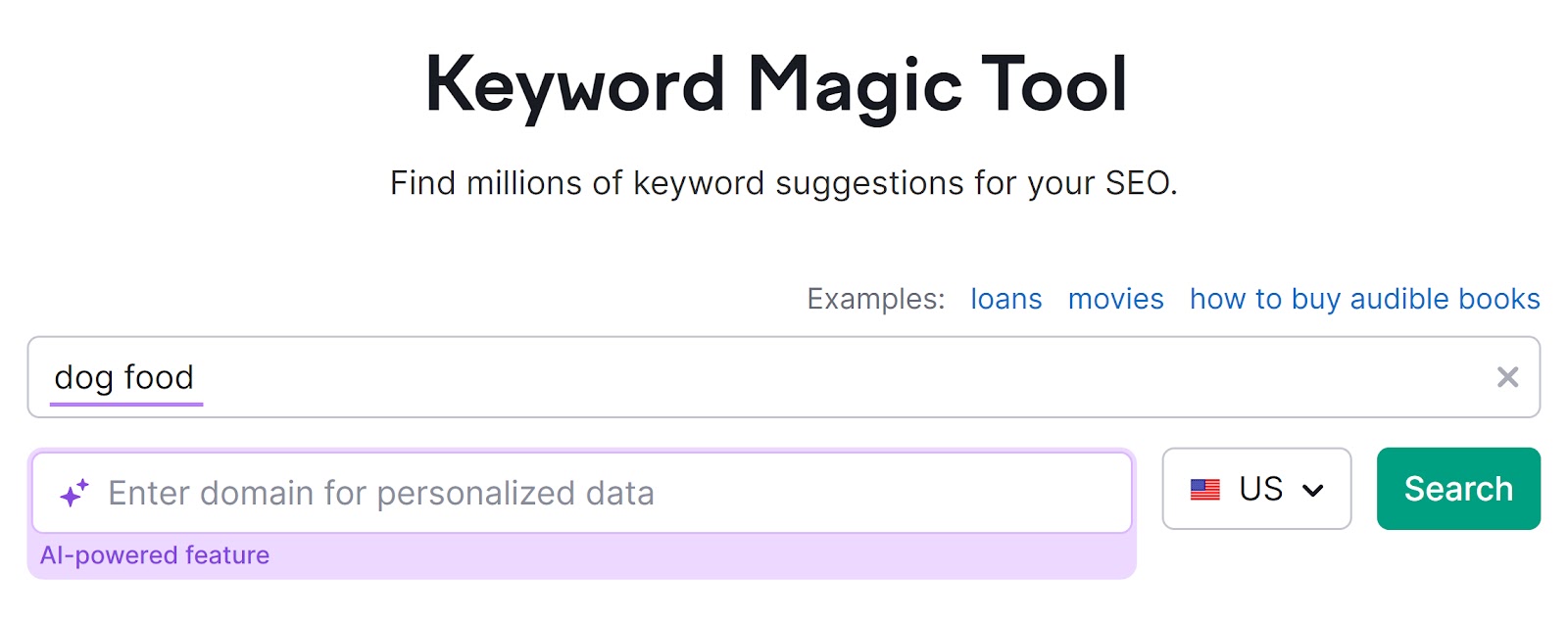
Then, enter your domain into the “AI-powered feature” field, choose your target location, and click “Search.”

This will generate a report with related keywords, each accompanied by valuable data: search intent, search volume, Personal Keyword Difficulty (PKD%), and Keyword Difficulty (KD%).
- KD% indicates how difficult it is to rank for a particular keyword
- PKD% considers your website's unique strength. And gives you a personalized score of how difficult it would be for your site to rank.
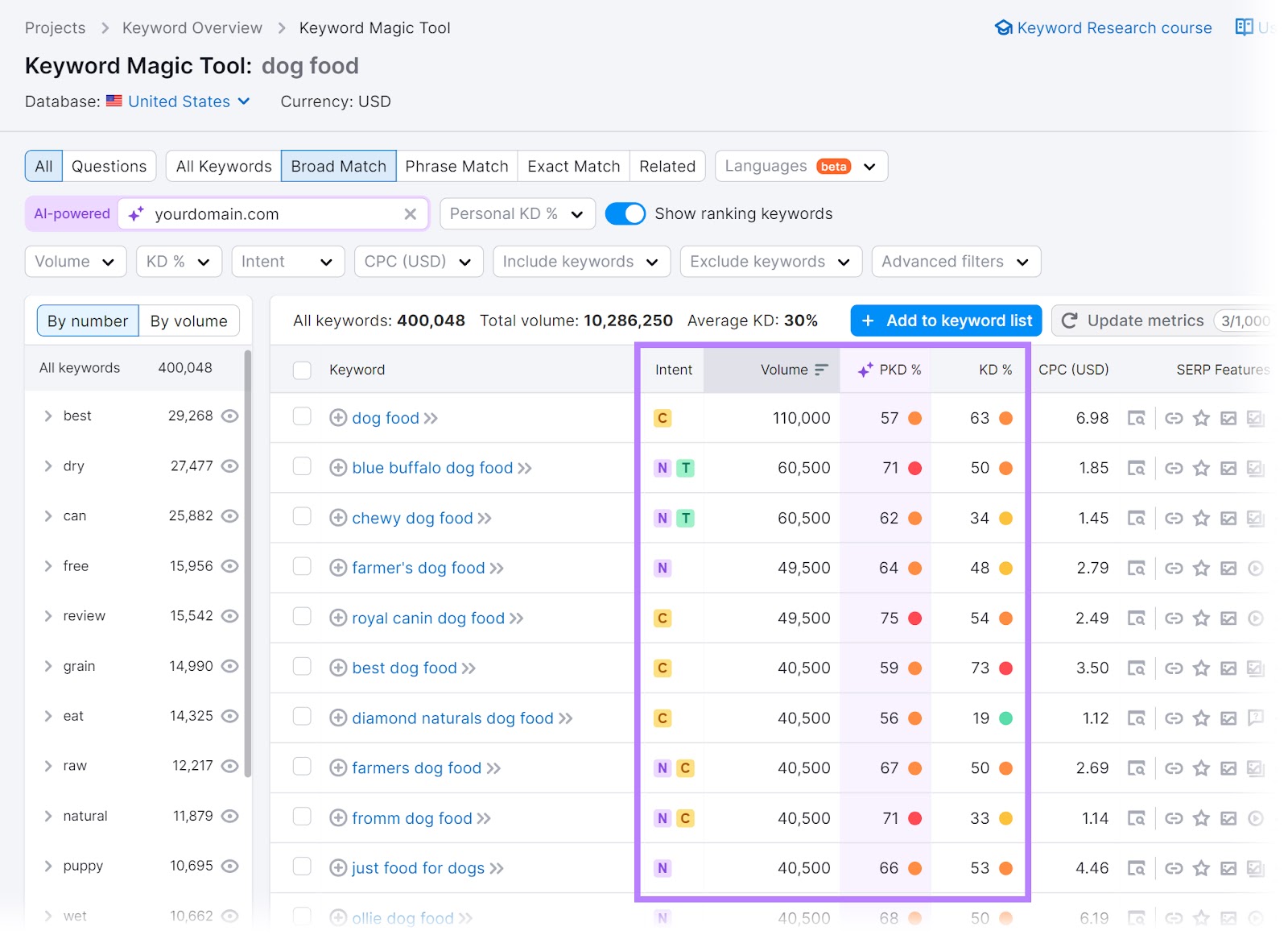
The left sidebar displays the most popular topics related to your seed keyword.
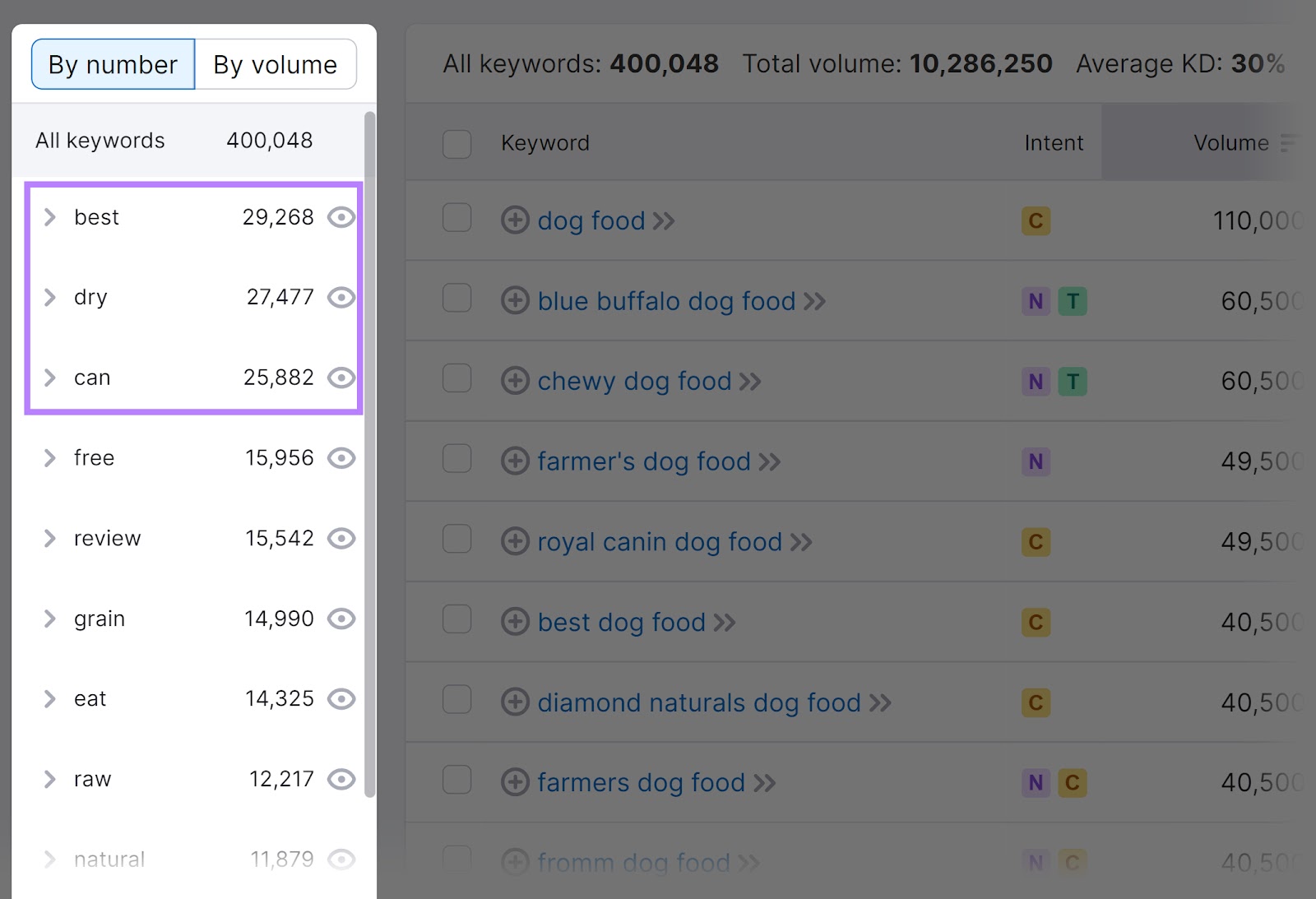
In this case, these are:
- Best (e.g., “best dog food”)
- Dry (e.g., “dry dog food brands”)
- Can (e.g., “can dogs eat X”)
Clicking on one will show all the keywords relating to that topic.
If any topics aren't relevant to your content, hide them using the eye icon.
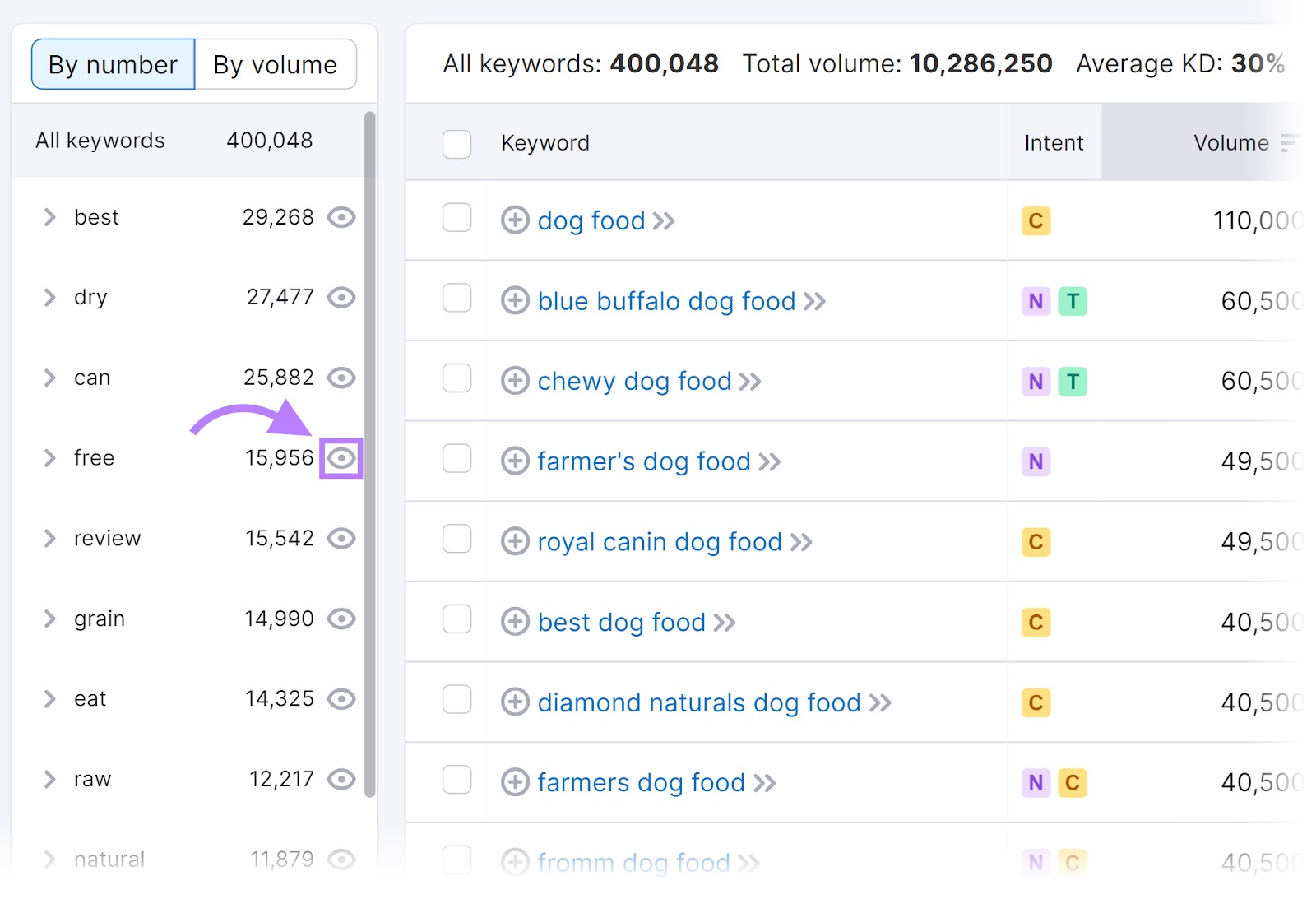
Clicking parent subgroups will show child group keywords.
For example, “can” + “puppy” + “eat” will show question-based keywords about the kinds of foods puppies can eat.
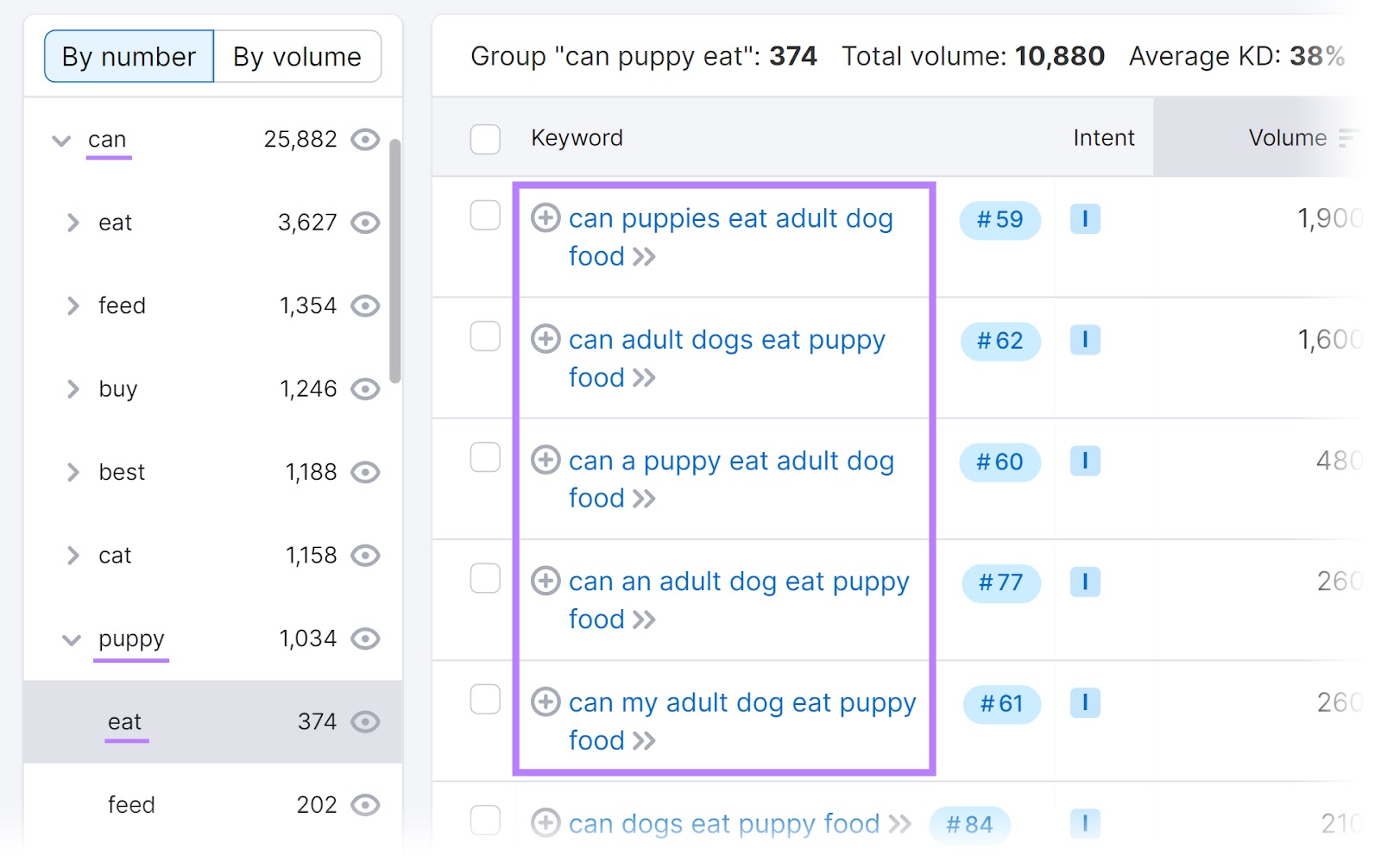
Now, here's where the magic happens:
Click on the "PKD%" drop-down menu and select "Easy."
This will filter the results to show keywords that should be relatively easy for your site to rank for, provided you create high-quality content that aligns with the search intent.
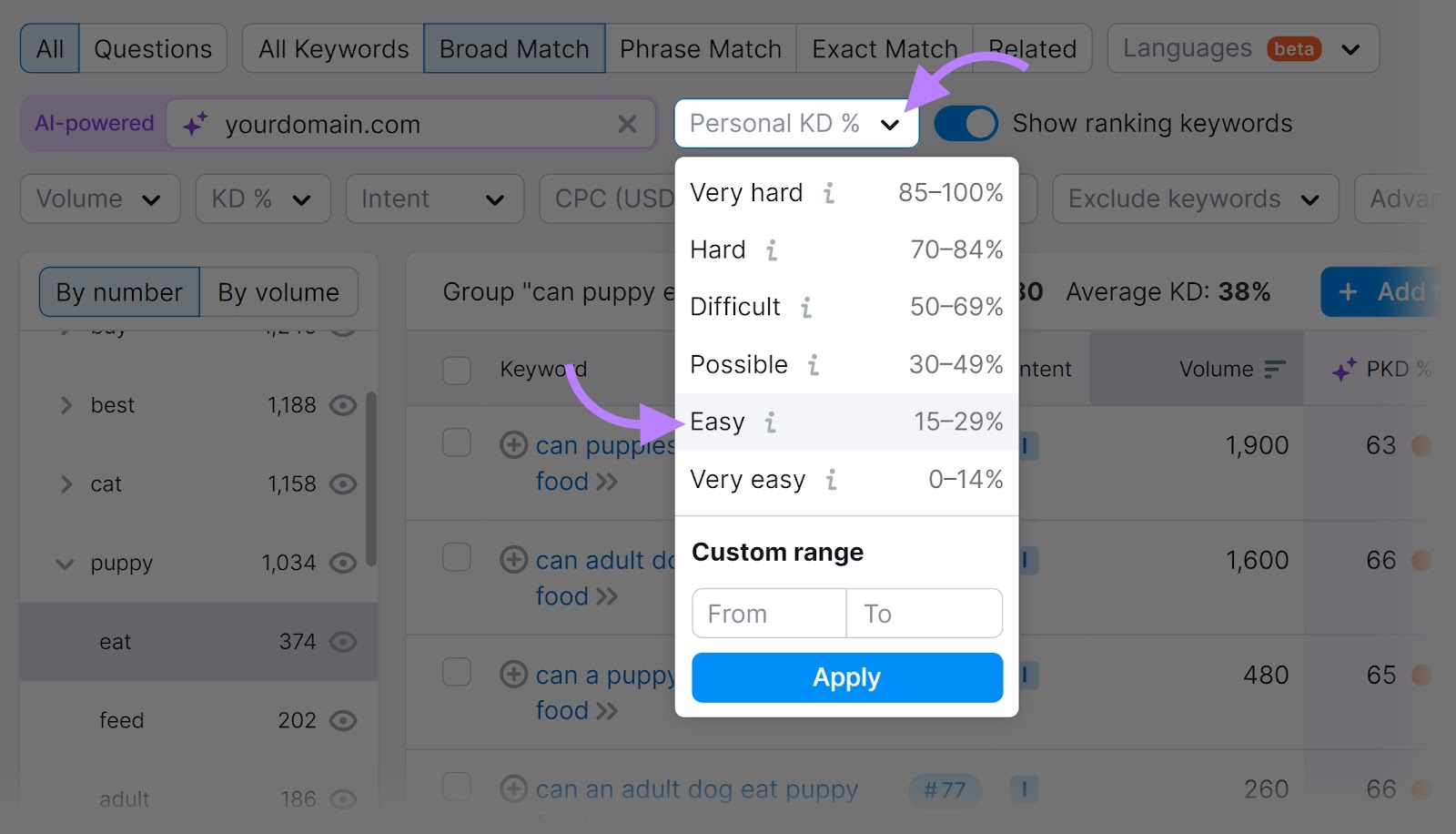
This will filter the results to show keywords that should be relatively easy to rank with high-quality content focused on the search intent.
From this refined list, choose a keyword that best reflects your desired topic and can attract relevant traffic.
This focused approach will help you revitalize your thin content and increase its visibility in search results.
Repurpose It
You can also repackage thin content into a new format to make it more valuable and draw renewed attention. This is called repurposing.
You’ll likely have to optimize it first to add value (e.g., address recent trends, add new relevant sections, or go deeper into an explanation). Then, repurpose it.
For example, turn a written piece of content into a new multimedia version, like an infographic summarizing a blog post.
Infographics combine engaging visuals with interesting data to draw the reader in. They can be a great addition to blog posts, making the value of the content more immediately apparent.
For instance, consider this infographic from our 10 SEO copywriting tips blog post:
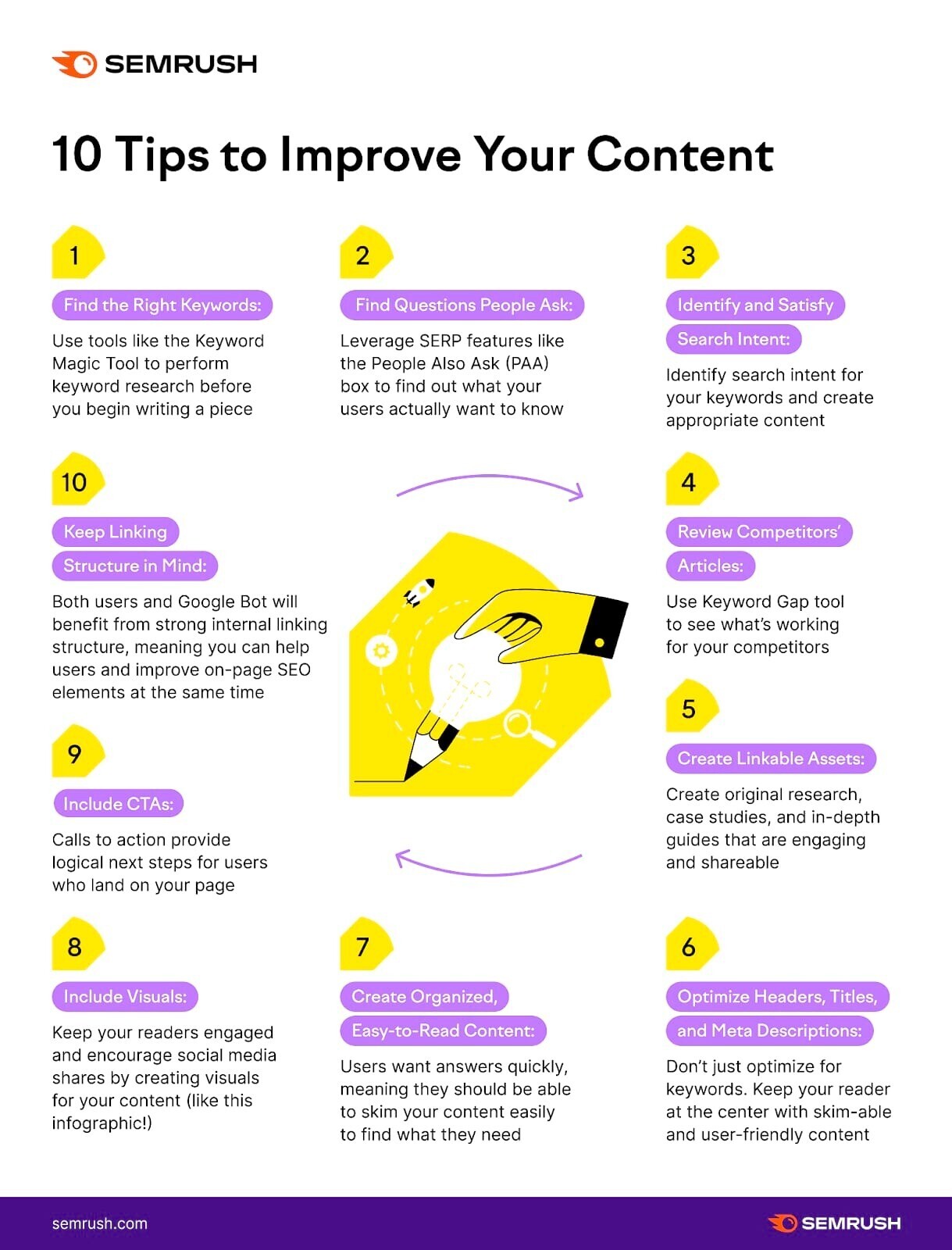
Plus, infographics are super shareable. So, you can get more visibility for your content when readers repost the images on X or Instagram.
Another way of repurposing thin content is to go deeper with video. For example, record a webinar or interview other guests using the narrative of your thin content to create talking points or questions.
This provides you with more opinions, information, and experiences for richer content.
Upload the finished recording on the original page to boost its value.
You can even repurpose these recordings further into short clips for your own social media accounts.
In 2023, 90% of marketers said video content helped them generate leads. And 87% said it helped them increase sales.
So, it’s worth a shot.
To streamline the repurposing process, consider using content repurposing tools like AI Video Marketing Automator, an app that lets you easily repurpose blog content into YouTube, TikTok, and Instagram videos.
Further reading: Repurposing Content: How to Get More Out of Every Piece
Delete It
You can delete content that is completely useless, is out-of-date, or has no backlinks.
This helps tidy up your website and ensures search engines only see your best content.
Before you delete anything, check if the pages have any backlinks.
If they do, consider redirecting those pages so the backlinks still provide some SEO benefits.
Redirecting means sending people who click the old link to a new, relevant page instead. Check out our guide to redirection for more information.
You will also want to double-check internal links pointing to the URL. Choose if you want to delete them or update them to the redirected page.
Further reading: Check out our content pruning guide to learn more about identifying and deleting low-value content.
Find and Fix Thin Content on Your Site
The quickest and easiest way to start your “thin content” audit is to root out technical issues causing Google to label your site as “thin.”
Take this first step by heading to the Site Audit tool and reviewing each issue individually.
Once you’ve done that, take your content quality to the next level with Semrush's suite of tools designed to streamline your content creation process:
- Organic Research: Uncover your competitors' top-performing content and gain insights to refine your content strategy
- Keyword Magic Tool: Discover relevant keywords with lower competition to target and optimize your content for better search visibility
- Keyword Strategy Builder: Visualize and build an entire SEO content strategy using Topics and Pages
- SEO Writing Assistant: Get real-time feedback on your content's readability, originality, and tone of voice, ensuring it's clear, engaging, and optimized for search engines
